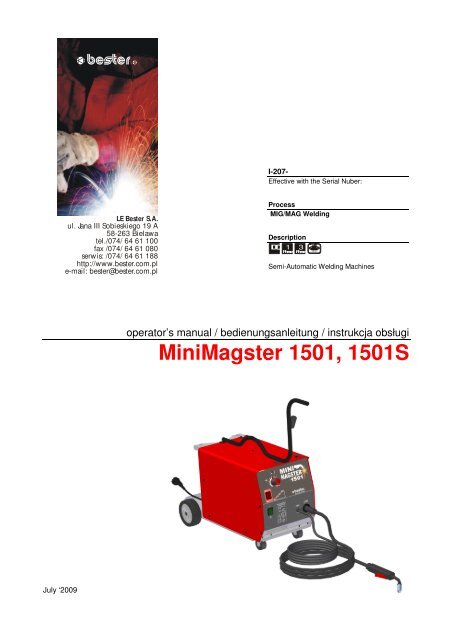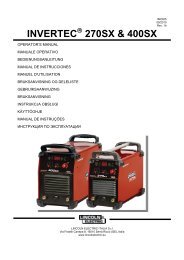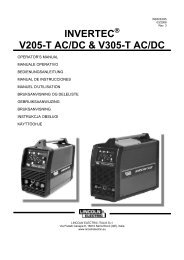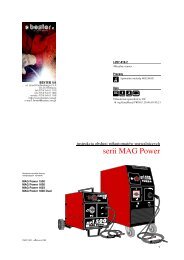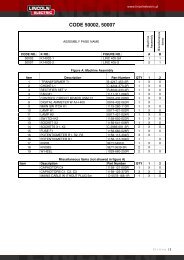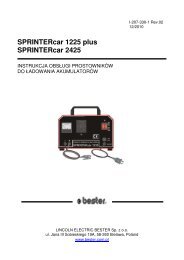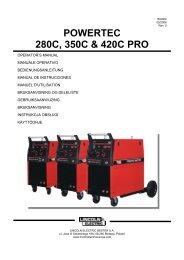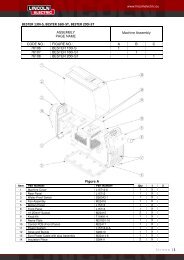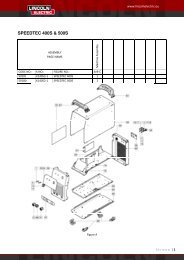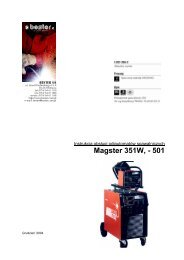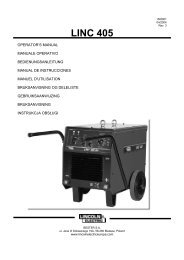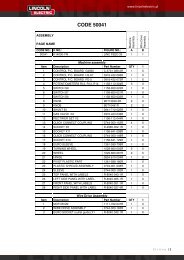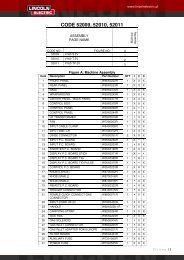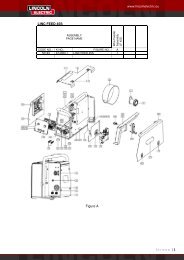MiniMagster 1501, 1501S - Lincoln Electric - documentations
MiniMagster 1501, 1501S - Lincoln Electric - documentations
MiniMagster 1501, 1501S - Lincoln Electric - documentations
Erfolgreiche ePaper selbst erstellen
Machen Sie aus Ihren PDF Publikationen ein blätterbares Flipbook mit unserer einzigartigen Google optimierten e-Paper Software.
R<br />
I-207-<br />
Effective with the Serial Nuber:<br />
LE Bester S.A.<br />
ul. Jana III Sobieskiego 19 A<br />
58-263 Bielawa<br />
tel./074/ 64 61 100<br />
fax /074/ 64 61 080<br />
serwis: /074/ 64 61 188<br />
http://www.bester.com.pl<br />
e-mail: bester@bester.com.pl<br />
Process<br />
MIG/MAG Welding<br />
Description<br />
DC 1<br />
Phase<br />
3<br />
Phase<br />
<br />
Semi-Automatic Welding Machines<br />
operator’s manual / bedienungsanleitung / instrukcja obsługi<br />
<strong>MiniMagster</strong> <strong>1501</strong>, <strong>1501</strong>S<br />
July ‘2009
THANK YOU! For your appreciate of quality of LE Bester S.A. products.<br />
• Please check if the packaging and product aren’t damaged. The complaint of damage, which was accrued during<br />
transportation must be submitted immediately for the deliverer (the distributor).<br />
• For convenience, please write the identification data of the product in this page, i.e. Model Name, Code and Serial<br />
Number. You can find those date on the name plate of the product.<br />
Wir Danken Ihnen! Für die Auswahl eins Qualitätsprodukts des LE Bester S.A. GmbH.<br />
Prüfen Sie Bitte ob die Verpackung und die Einrichtung nicht beschädigt sind. Die Reklamationen der<br />
Transportbeschädigungen sollen sofort an der Lieferant angemeldet werden.<br />
Für Erleichterung schreiben Sie bitte auf diese Seite die identifizierungs- Daten. Modell Name, Code und<br />
Seriennummer können Sie am Erzeugnisschild finden.<br />
DZIKUJEMY! Za docenienie JAKOCI produktów LE Bester S.A.<br />
• Prosz sprawdzi czy opakowanie i sprzt nie s uszkodzone. Reklamacje uszkodze powstałych podczas<br />
transportu musz by natychmiast zgłoszone do dostawcy (dystrybutora).<br />
• Dla ułatwienia prosimy o zapisanie na tej stronie danych identyfikacyjnych wyrobów. Nazwa modelu, Kod i Numer<br />
Seryjny, które moecie Pastwo znale na tabliczce znamionowej wyrobu.<br />
Nie wyrzuca osprztu elektrycznego razem z normalnymi odpadami!<br />
Zgodnie z Dyrektyw Europejsk 2002/96/EC dotyczc Pozbywania si zuytego Sprztu Elektrycznego i<br />
Elektronicznego (Waste <strong>Electric</strong>al and Electronic Equipment, WEEE) i jej wprowadzeniem w ycie zgodnie<br />
z midzynarodowym prawem, zuyty sprzt elektryczny musi by składowany oddzielnie i specjalnie<br />
utylizowany. Jako właciciel urzdze powiniene otrzyma informacje o zatwierdzonym systemie<br />
składowania od naszego lokalnego przedstawiciela.<br />
Stosujc te wytyczne bdziesz chronił rodowisko i zdrowie człowieka!<br />
Die elektrische Einrichtungen soll man nicht zusammen mit Haushaltmühle hinauswerfen!<br />
Gemäß Europeische Direktive 2002/96/EC betrifft Gebrauchte Elektrische und Elektronische Einrichtungen<br />
Loswerden (WEEE) und Sie in Benutzung, gemäß Internationale Recht, Einführung gebrauchte elektrische<br />
Einrichtungen sollen getrennt lagern sein und speziell utilisiert. Als Einrichtungen Besitzer sollen Sie die<br />
Auskunft über bestätigten Lagersystem von unserem Ortsverträter bekommen.<br />
Diese Gesetze beobachten hilft Umwelt und Menschen Gesundheit Schutzen.<br />
Do not dispose of electrical equipment together with normal waste!<br />
In observance of European Directive 2002/96/EC on Waste <strong>Electric</strong>al and Electronic Equipment (WEEE)<br />
and its implementation in accordance with national law, electrical equipment that has reached the end of its<br />
life must be collected separately and returned to an environmentally compatible recycling facility. As the<br />
owner of the equipment, you should get information on approved collection systems from our local<br />
representative.<br />
By applying this European Directive you will protect the environment and human health!<br />
Model Name/ Modell Name/Nazwa modelu:<br />
………………...…………………………….…………………………………………………………………………………………..<br />
Code and Serial Number/ Code und Seriennummer/Kod i numer seryjny:<br />
………………….……………………………………………….. …………………………………………………….……………..<br />
Purches Date and Place/ Datum- und Platz des Ankaufes/Data i miejsce zakupu:<br />
…………………………………………………………………... ……………………….…………………………………………..<br />
3
Declaration of conformity<br />
Konformitätserklärung<br />
Deklaracja zgodnoci<br />
LE BESTER S.A.<br />
Declares that the welding machine:<br />
Erklärt, daß die Bauart der Maschine:<br />
Deklaruje, e spawalnicze ródło energii:<br />
<strong>MiniMagster</strong> <strong>1501</strong>, -<strong>1501</strong>S<br />
s/n<br />
conforms to the following directives:<br />
den folgenden Bestimmungen entspricht:<br />
spełnia nastpujce wytyczne:<br />
73/23/CEE, 93/68/CEE, 89/336/CEE, 92/31/CEE<br />
and has been designed in conformance with the following norms:<br />
und in Übereinstimmung mit den nachstehenden Normen hergestellt wurde:<br />
i e zostało zaprojektowane zgodnie z wymaganiami nastpujcych norm:<br />
EN 50199, EN 60974-1<br />
Paweł Lipiski<br />
Operational Director<br />
LE BESTER S.A., ul. Jana III Sobieskiego 19A, 58-260 Bielawa, Poland<br />
07/09<br />
4
ENGLISH INDEX<br />
Safety .............................................................................................................................................................................. 6<br />
Installation and Operator Instructions .............................................................................................................................. 7<br />
Electromagnetic Compatibility (EMC) ............................................................................................................................ 11<br />
Technical Specifications ................................................................................................................................................ 11<br />
INHALTSVERZEICHNIS DEUTSCH<br />
Sicherheitsmaßnahmen / Unfallschutz .......................................................................................................................... 12<br />
Installation und Bedienungshinweise ............................................................................................................................. 13<br />
Elektromagnetische Verträglichkeit (EMC) .................................................................................................................... 17<br />
Technische Daten .......................................................................................................................................................... 17<br />
SKOROWIDZ POLSKI<br />
Bezpieczestwo Uytkowania ....................................................................................................................................... 18<br />
Instrukcja Instalacji i Eksploatacji .................................................................................................................................. 19<br />
PrzepisyBHP...................................................................................................................................................................23<br />
Kompatybilno Elektromagnetyczna (EMC) ................................................................................................................. 24<br />
Dane Techniczne ........................................................................................................................................................... 24<br />
Spare Parts, Ersatzteile, Wykaz Czci Zamiennych .................................................................................................... 25<br />
<strong>Electric</strong>al Schematic, Elektrische Schaltpläne, Schemat Elektryczny ............................................................................ 30<br />
Accessories, Zubehör, Akcesoria .................................................................................................................................. 32<br />
5
Safety<br />
07/09<br />
WARNING<br />
This equipment must be used by qualified personnel. Be sure that all installation, operation, maintenance and repair<br />
procedures are performed only by qualified individuals. Read and understand this manual before operating this<br />
equipment. Failure to follow the instructions in this manual could cause serious personal injury, loss of life, or damage to<br />
this equipment. Read and understand the following explanations of the warning symbols. <strong>Lincoln</strong> <strong>Electric</strong> is not<br />
responsible for damages caused by improper installation, improper care or abnormal operation.<br />
WARNING: This symbol indicates that instructions must be followed to avoid serious personal injury,<br />
loss of life, or damage to this equipment. Protect yourself and others from possible serious injury or<br />
death.<br />
READ AND UNDERSTAND INSTRUCTIONS: Read and understand this manual before operating<br />
this equipment. Arc welding can be hazardous. Failure to follow the instructions in this manual could<br />
cause serious personal injury, loss of life, or damage to this equipment.<br />
ELECTRIC SHOCK CAN KILL: Welding equipment generates high voltages. Do not touch the<br />
electrode, work clamp, or connected work pieces when this equipment is on. Insulate yourself from<br />
the electrode, work clamp, and connected work pieces.<br />
FUMES AND GASES CAN BE DANGEROUS: Welding may produce fumes and gases hazardous to<br />
health. Avoid breathing these fumes and gases. To avoid these dangers the operator must use<br />
enough ventilation or exhaust to keep fumes and gases away from the breathing zone.<br />
ARC RAYS CAN BURN: Use a shield with the proper filter and cover plates to protect your eyes from<br />
sparks and the rays of the arc when welding or observing. Use suitable clothing made from durable<br />
flame-resistant material to protect you skin and that of your helpers. Protect other nearby personnel<br />
with suitable, non-flammable screening and warn them not to watch the arc nor expose themselves to<br />
the arc.<br />
WELDING SPARKS CAN CAUSE FIRE OR EXPLOSION: Remove fire hazards from the welding<br />
area and have a fire extinguisher readily available. Welding sparks and hot materials from the welding<br />
process can easily go through small cracks and openings to adjacent areas. Do not weld on any<br />
tanks, drums, containers, or material until the proper steps have been taken to insure that no<br />
flammable or toxic vapors will be present. Never operate this equipment when flammable gases,<br />
vapors or liquid combustibles are present.<br />
ELECTRICALLY POWERED EQUIPMENT: Turn off input power using the disconnect switch at the<br />
fuse box before working on this equipment. Ground this equipment in accordance with local electrical<br />
regulations.<br />
ELECTRICALLY POWERED EQUIPMENT: Regularly inspect the input, electrode, and work clamp<br />
cables. If any insulation damage exists replace the cable immediately. Do not place the electrode<br />
holder directly on the welding table or any other surface in contact with the work clamp to avoid the<br />
risk of accidental arc ignition.<br />
ELECTRIC AND MAGNETIC FIELDS MAY BE DANGEROUS: <strong>Electric</strong> current flowing through any<br />
conductor creates electric and magnetic fields (EMF). EMF fields may interfere with some<br />
pacemakers, and welders having a pacemaker should consult their physician before operating this<br />
equipment.<br />
NOISE APPEARES DURING WELDING CAN BE HARMFUL: Welding arc can cause noise with high<br />
level of 85dB for 8-hour week day. Welders operating welding machines are obligated to wear the<br />
proper ear protectors /appendix No. 2 for the Decree of the Secretary of Labor and Social Policy from<br />
17.06 1998 – Dz.U. No. 79 pos. 513/. According to the Decree the Secretary of Health and Social<br />
Welfare from 09.07.1996 /Dz.U. No. 68 pos. 194/, employers are obligated to carry examinations and<br />
measurements of health harmful factors.<br />
CYLINDER MAY EXPLODE IF DAMAGED: Use only compressed gas cylinders containing the<br />
correct shielding gas for the process used and properly operating regulators designed for the gas and<br />
pressure used. Always keep cylinders in an upright position securely chained to a fixed support. Do<br />
not move or transport gas cylinders with the protection cap removed. Do not allow the electrode,<br />
electrode holder, work clamp or any other electrically live part to touch a gas cylinder. Gas cylinders<br />
must be located away from areas where they may be subjected to physical damage or the welding<br />
process including sparks and heat sources.<br />
6
WELDED MATERIALS CAN BURN: Welding generates a large amount of heat. Hot surfaces and<br />
materials in work area can cause serious burns. Use gloves and pliers when touching or moving<br />
materials in the work area.<br />
CE COMPLIANCE: This equipment complies to the European Communities directives.<br />
SAFETY MARK: This equipment is suitable for supplying power for welding operations carried out in<br />
an environment with increased hazard of electric shock.<br />
MOVING PARTS ARE DANGEROUS: There are moving mechanical parts in this machine, which can<br />
cause serious injury. Keep your hands, body and clothing away from those parts during machine<br />
starting, operating and servicing.<br />
Installation and Operator Instructions<br />
Read this entire section before installation or operation<br />
of the machine.<br />
Location and Environment<br />
This machine will operate in harsh environments.<br />
However, it is important that simple preventative<br />
measures are followed to assure long life and reliable<br />
operation.<br />
• Do not place or operate this machine on a surface<br />
with an incline greater than 15° from horizontal.<br />
• This machine must be located where there is free<br />
circulation of clean air without restrictions for air<br />
movement to and from the air vents. Do not cover the<br />
machine with paper, cloth or rags when switched on.<br />
• Dirt and dust that can be drawn into the machine<br />
should be kept to a minimum.<br />
• This machine has a protection rating of IP21. Keep it<br />
dry when possible and do not place it on wet ground<br />
or in puddles.<br />
• Locate the machine away from radio controlled<br />
machinery. Normal operation may adversely affect<br />
the operation of nearby radio controlled machinery,<br />
which may result in injury or equipment damage.<br />
Read the section on electromagnetic compatibility in<br />
this manual.<br />
• Do not operate in areas with an ambient temperature<br />
greater than 40°C.<br />
Duty Cycle and Overheating<br />
The duty cycle of a welding machine is the percentage<br />
of time in a 10 minute cycle at which the welder can<br />
operate the machine at rated welding current.<br />
Example: 60% Duty Cycle:<br />
Minutes<br />
or decrease<br />
Duty Cycle<br />
Handle Fastening<br />
• Unpack the machine.<br />
• Unpack the handle.<br />
• Unscrew for screws fastening the top cover to the<br />
chassis.<br />
• Match the handle to the four holes on the top cover<br />
and screw it with four screws.<br />
Input Supply Connection<br />
Input connection of the welder and its grounding should<br />
be done according to valid standards PN-E – 05009<br />
“<strong>Electric</strong>al Installation in buildings”.<br />
<strong>MiniMagster</strong> <strong>1501</strong> is adopted to 1-phase, 3-wire<br />
power supply network 230V, 50Hz protected with the<br />
Superlag fuse 16 A.<br />
Welding for 6 minutes.<br />
Break for 4 minutes.<br />
Excessive extension of the duty cycle will cause the<br />
thermal protection circuit to activate. See “Technical<br />
Specification”.<br />
<strong>MiniMagster</strong> <strong>1501</strong>S is adopted to 1-phase, 3-wire<br />
230V, 50 Hz power supply network, protected with the<br />
Superlag fuse 16 A or to 3-phase, 5-wire 400V. 50<br />
Hz power supply network protected with the Superlag<br />
fuse 10 A. Power supply socket should have<br />
naturalization terminal.<br />
7
<strong>MiniMagster</strong> <strong>1501</strong>S is equipped with two input power<br />
cords for two types of power supply. Change of the<br />
power supply can be done by the power supply<br />
switch, which is placed on the rear panel of the<br />
welder.<br />
the wire is cut by the drive roll or is locked in the guide<br />
tube. Turning the thumbscrew to the right – pressure<br />
increasing, turning the thumbscrew to the left –<br />
pressure decreasing.<br />
Before connecting the welder to the power supply<br />
network , make sure if the main switch is “0” (switched<br />
off).<br />
Shielding Gas Connection<br />
To connect shielding gas, you should:<br />
After placing the shielding gas cylinder on the platform,<br />
protect it against to overturn with the chain.<br />
Take off the hub cap of the safety valve of the shielding<br />
gas cylinder.<br />
Install the regulator on the gas cylinder.<br />
Connect the regulator to the <strong>MiniMagster</strong> with gas hose<br />
using band clip.<br />
Wire Loading<br />
ATTENTION<br />
Before wire loading, turn machine power switch to<br />
the OFF (“0”) position before working inside the<br />
wire feed enclosure.<br />
To load wire you should do the following sequence of<br />
operations:<br />
Push the spool onto the spindle so that the wire<br />
feeds off the bottom of the spool, toward the<br />
drive roll.<br />
5 kg spool push onto the shorter part of the spindle<br />
with bigger diameter and 0,5 kg spool push onto the<br />
longer part of the spindle with smaller diameter.<br />
To lock the spool, push the spool spacer onto the<br />
spindle. For 5 kg spool with the spool spacer flange<br />
inward and for 0.5 kg spool with the spool spacer<br />
flange outside.<br />
Slide the spring onto the spool spacer, then press on<br />
the spool lock, turning it clockwise to lock the spool<br />
assembly onto the spindle.<br />
Release the spring loaded thumbscrew and rotate the<br />
idle roll arm away from the wire feed drive roll.<br />
Ensure that the visible, stenciled size on the drive roll<br />
side facing you matches the wire size being used.<br />
Carefully detach the end of the wire from the spool<br />
maintain tension on the wire to prevent the spool from<br />
unwinding.<br />
Thread the wire through the ingoing guide tube.<br />
Thread the wire over the drive roll, and into the gun<br />
liner.<br />
Close the idle roll arm and turn down the thumbscrew<br />
until the idle roller presses down firmly on the wire.<br />
Remove the nozzle and contact tip from the gun.<br />
Turn the machine ON (“I”).<br />
Point the gun away so that outgoing wire doesn’t cut<br />
the welder and other people standing nearby.<br />
Depress the gun trigger switch and welding wire<br />
should move towards the end of the gun.<br />
ATTENTION<br />
Don’t look into the outlet of the gun during cold<br />
inching - going out wire can seriously injure your<br />
eye.<br />
After going out the wire into the gun outlet (about 20<br />
mm), release the gun trigger switch and twist the<br />
contact tip suitable for the wire diameter being used.<br />
Adjust pressure by turning thumbscrew. Pressure too<br />
low – drive roll slips on the wire; pressure too high –<br />
Sleeve<br />
Spool with wire: A - 5 kg, B - 0,5 kg<br />
Spool spacer<br />
Spring<br />
Spool lock<br />
Changing Polarity of the Output<br />
Voltage<br />
Welding with Positive Polarity (DC+)<br />
As delivered the machine is wired for Positive Polarity.<br />
To wire for Positive polarity, connect the gun cable to<br />
the Positive (+) output terminal and the work cable to<br />
the Negative (-) terminal.<br />
Welding with Negative Polarity (DC-)<br />
To wire for Negative Polarity, connect the gun cable to<br />
8
the Negative (-) output terminal and the work cable to<br />
the Positive (+) terminal. This is the typical<br />
configuration for Flux Cored Welding (FCAW).<br />
Controls and Operational Features of<br />
the <strong>MiniMagster</strong> <strong>1501</strong> and <strong>1501</strong>S<br />
2. Hose: For shielding gas connecting.<br />
3. Cooling Fun Holes: Don’t cover!<br />
4. Shelf: For placing the gas cylinder .<br />
WARNING<br />
After installation, protect the shielding gas cylinder<br />
from overturn with the chain. Don’t place any gas<br />
cylinder over 10 l – it can cause overturning the<br />
welder.<br />
Rear Panel of the <strong>MiniMagster</strong> <strong>1501</strong>S<br />
1. Power Switch: Turns the machine on/off. Switching<br />
on is indicated by lighting up of the switch button.<br />
2. WFS (Wire Feed Speed) Knob: 10-position scale<br />
enables stepless WFS control in a range of 0 -<br />
18.0m/min.<br />
3. Welding Voltage Changing Switche: enables four<br />
values of welding voltage step selection: MIN1,<br />
MIN2, MAX1 and MAX2.<br />
WARNING<br />
It is not allowed changing the welding voltage<br />
range during welding process! It may damage<br />
the switch.<br />
4. Thermal Protection Indicator: The lamp indicates<br />
overheating of the machine.<br />
5. Welding Gun: Supplies welding voltage and<br />
shielding gas and feeds electrode wire.<br />
6. Ground Cable with the Work Clamp.<br />
Rear Panel of the <strong>MiniMagster</strong> <strong>1501</strong><br />
1. Input Power Cord with the Plug.<br />
1. 230V Input Power Cord with the Plug.<br />
2. 400V Input Power Cord with the Plug.<br />
3. Hose: For shielding gas connecting.<br />
4. Cooling Fun Holes: Don’t cover!<br />
5. Shelf : For placing the gas cylinder .<br />
WARNING<br />
After installation, protect the shielding gas cylinder<br />
from overturn with the chain. Don’t place gas cylinder<br />
over 10 l – it can cause overturning the<br />
welder.<br />
6. Power Supply Change Switch<br />
WARNING<br />
It is not allowed changing the welding voltage<br />
range during welding process! It may damage<br />
the switch.<br />
Final Actions<br />
Connect the work cable to the work with the work<br />
clamp.<br />
Connect the gas cylinder to the gas input through the<br />
gas regulator.<br />
Insert the plug of the power input cord into the mains<br />
power socket.<br />
Switch on the welder with the power switch. Switching<br />
on is indicated by lighting up of the power indicator.<br />
Based on the seam kind, join type and material<br />
thickness of the work piece, chose correct welding<br />
settings with the welding voltage switch and WFS<br />
control.<br />
Obeying the appropriate regulations, you can begin to<br />
weld.<br />
MIG/MAG Welding<br />
The MIG/MAG Welding method requires adjusting only<br />
two parameters:<br />
9
- welding voltage<br />
- electrode wire speed (WFS).<br />
Below it was presented several recommendations,<br />
which make easier to select welding parameters:<br />
WFS increasing causes arc length shortening,<br />
welding current increasing and joint penetration<br />
increasing.<br />
WFS decreasing causes arc length extension, welding<br />
current decreasing and join penetration decreasing.<br />
Welding voltage increasing causes arc length<br />
extension.<br />
Welding voltage decreasing causes arc length<br />
shortening.<br />
Too high WFS causes pushing up of the welding gun.<br />
The electrode wire doesn’t keep up to melt into the<br />
arc and it pushes away the gun.<br />
Too low WFS or too high welding voltage creates big<br />
drops on the end of the wire, which fall down beside<br />
melted pool.<br />
Too big splashing indicates too low welding voltage or<br />
too high WFS.<br />
Flux Cored Welding<br />
To adopt welders <strong>MiniMagster</strong> <strong>1501</strong> and <strong>1501</strong>S for Flux<br />
Cored Welding, you should:<br />
Mount the spool with flux cored wire onto the spindle.<br />
Change the output voltage polarity in the wire feeder<br />
chamber.<br />
Put on the drive roll marked 0.9V/1.2V .<br />
Match accessories of the welding gun for welding with<br />
cored wire (contact tip140.D418 and nozzle<br />
145.D258).<br />
Spot Welding<br />
Semiautomatic welders <strong>MiniMagster</strong> <strong>1501</strong> and <strong>1501</strong>S<br />
can be applied for spot welding – for welding thin parts<br />
e.g. metal sheets.<br />
To do it, you should:<br />
Install the special gas nozzle for spot welding. It is<br />
equipped with pins to pressure welded parts and it<br />
provides free gas flow.<br />
Set the welding settings according to the previous<br />
discussed rules.<br />
Welding time essentially influence on the joint quality:<br />
- too long - causes too big metal penetration<br />
- too short - joint lack.<br />
Welding Process<br />
10
Electromagnetic Compatibility (EMC)<br />
This machine has been designed in accordance with all relative directives and norms. However, it may still generate<br />
electromagnetic disturbances that can affect other systems like telecommunications (telephone, radio, and television) or<br />
other safety systems. These disturbances can cause safety problems in the affected systems. Read and understand<br />
this section to eliminate or reduce the amount of electromagnetic disturbance generated by this machine.<br />
This machine has been designed to operate in an industrial area. To operate in a domestic area it is<br />
necessary to observe particular precautions to eliminate possible electromagnetic disturbances. The<br />
operator must install and operate this equipment as described in this manual. If any electromagnetic<br />
disturbances are detected the operator must put in place corrective actions to eliminate these disturbances<br />
with, if necessary, assistance from <strong>Lincoln</strong> <strong>Electric</strong>.<br />
Before installing the machine, the operator must check the work area for any devices that may malfunction because of<br />
electromagnetic disturbances. Consider the following.<br />
• Input and output cables, control cables, and telephone cables that are in or adjacent to the work area and the<br />
machine.<br />
• Radio and/or television transmitters and receivers. Computers or computer controlled equipment.<br />
• Safety and control equipment for industrial processes. Equipment for calibration and measurement.<br />
• Personal medical devices like pacemakers and hearing aids.<br />
• Check the electromagnetic immunity for equipment operating in or near the work area. The operator must be sure<br />
that all equipment in the area is compatible. This may require additional protection measures.<br />
• The dimensions of the work area to consider will depend on the construction of the area and other activities that are<br />
taking place.<br />
Consider the following guidelines to reduce electromagnetic emissions from the machine.<br />
• Connect the machine to the input supply according to this manual. If disturbances occur if may be necessary to take<br />
additional precautions such as filtering the input supply.<br />
• The output cables should be kept as short as possible and should be positioned together. If possible connect the<br />
work piece to ground in order to reduce the electromagnetic emissions. The operator must check that connecting<br />
the work piece to ground does not cause problems or unsafe operating conditions for personnel and equipment.<br />
• Shielding of cables in the work area can reduce electromagnetic emissions. This may be necessary for special<br />
applications.<br />
07/09<br />
Technical Specifications<br />
<strong>MiniMagster</strong> <strong>1501</strong>, <strong>1501</strong>S<br />
INPUT PARAMETERS<br />
Input Voltage<br />
Maximum Input Maximum Power<br />
Current<br />
Consumption<br />
Power Factor<br />
<strong>MiniMagster</strong> <strong>1501</strong> 230V ±10%, 50 Hz 18.6 A 4.7 kVA 0.97<br />
<strong>MiniMagster</strong> <strong>1501</strong>S<br />
230V ±10%, 50 Hz 18.6 A 4.7 kVA 0.97<br />
400V ±10%, 50 Hz 10.9 A 4.7 kVA 0.97<br />
OUTPUT PARAMETERS<br />
Duty Cycle<br />
Output Circuit<br />
(Based on a 10 min. period)<br />
Output Current Welding Current Range<br />
Voltage<br />
<strong>MiniMagster</strong> <strong>1501</strong><br />
<strong>MiniMagster</strong> <strong>1501</strong>S<br />
X20 %<br />
X60 %<br />
X100 %<br />
X20 %<br />
X60 %<br />
X100 %<br />
(230 V)<br />
115 A<br />
65 A<br />
50 A<br />
115 A<br />
65 A<br />
50 A<br />
(400 V)<br />
115 A<br />
65 A<br />
50 A<br />
(230V)<br />
40 - 115 A<br />
40 - 115 A 19 – 32 V<br />
(400V)<br />
65 - 115 A<br />
(230V)<br />
19 - 32 V<br />
(400V)<br />
24 – 32 V<br />
OTHER PARAMETERS<br />
Degree Insulation<br />
Welding Voltage Operating<br />
WFS Range<br />
Operating Humidity<br />
Protection Class<br />
Steps<br />
Temperature<br />
IP21 H 0 - 18 m/min 4 od -10 do +40 C 90 %<br />
RECOMMENDED FUSE SIZES WEIGHT Dimensions W x H x D<br />
<strong>MiniMagster</strong> <strong>1501</strong> 16 A Superlag 32 kg<br />
<strong>MiniMagster</strong> <strong>1501</strong>S 16 A (230V) /10 A (400V) Superlag 35 kg<br />
365 x 383 x 635 mm<br />
11
Sicherheitsmaßnahmen / Unfallschutz<br />
07/09<br />
ACHTUNG<br />
Diese Anlage darf nur von ausgebildeten Leuten benutzt, gewartet und repariert werden. Schließen Sie dieses Gerät<br />
nicht an, arbeiten Sie nicht damit oder reparieren Sie es nicht, bevor Sie diese Betriebsanleitung gelesen und verstanden<br />
haben. Bei Nichtbeachtung der Hinweise kann es zu gefährlichen Verletzungen bis hin zum Tod oder zu<br />
Beschädigungen am Gerät kommen. Beachten Sie auch die folgenden Beschreibungen der Warnhinweise. <strong>Lincoln</strong><br />
<strong>Electric</strong> ist nicht verantwortlich für Fehler, die durch inkorrekte Installation, mangelnde Sorgfalt oder Fehlbenutzung des<br />
Gerätes entstehen.<br />
ACHTUNG: Dieses Symbol gibt an, dass die folgenden Hinweise beachtet werden müssen, um<br />
gefährliche Verletzungen bis hin zum Tode oder Beschädigungen am Gerät zu verhindern. Schützen<br />
Sie sich und andere vor gefährlichen Verletzungen oder dem Tode.<br />
BEACHTEN SIE DIE ANLEITUNG: Lesen Sie diese Anleitung sorgfältig, bevor Sie das Gerät in<br />
Betrieb nehmen. Bei Nichtbeachtung der Hinweise kann es zu gefährlichen Verletzungen bis hin zum<br />
Tod oder zu Beschädigungen am Gerät kommen.<br />
STROMSCHLÄGE KÖNNEN TÖDLICH SEIN: Schweißgeräte erzeugen hohe Stromstärken.<br />
Berühren Sie keine stromführenden Teile oder die Elektrode mit der Haut oder nasser Kleidung.<br />
Schützen Sie beim Schweißen Ihren Körper durch geeignete isolierende Kleidung und Handschuhe.<br />
RAUCH UND GASE KÖNNEN GEFÄHRLICH SEIN: Schweißen erzeugt Rauch und Gase, die<br />
gesundheitsschädlich sein können. Vermeiden Sie das Einatmen dieser Metalldämpfe. Benutzen Sie<br />
eine Schweißrauchabsaugung, um die Dämpfe abzusaugen.<br />
LICHTBÖGEN KÖNNEN VERBRENNUNGEN HERVORRUFEN: Tragen Sie geeignete Schutzkleidungen<br />
und Schutzmasken für Augen, Ohren und Körper, um sich vor Spritzern und Strahlungen<br />
zu schützen. Warnen Sie auch in der Umgebung befindliche Personen vor den Gefahren des<br />
Lichtbogens. Lassen Sie keinen ungeschützt den Lichtbogen beobachten.<br />
SCHWEISSPRITZER KÖNNEN FEUER ODER EXPLOSIONEN VERURSACHEN: Entfernen Sie<br />
feuergefährliche Gegenstände vom Schweißplatz und halten Sie einen Feuerlöscher bereit.<br />
Schweißen Sie keine Behälter, die brennbare oder giftige Stoffe enthalten, bis diese vollständig<br />
geleert und gesäubert sind. Schweißen Sie niemals an Orten, an denen brennbare Gase, Stoffe oder<br />
Flüssigkeiten vorhanden sind.<br />
ELEKTRISCHE GERÄTE: Schalten Sie die Netzspannung am Sicherungskasten aus oder ziehen Sie<br />
den Netzstecker, bevor Arbeiten an der Maschine ausgeführt werden. Erden Sie die Maschine<br />
gemäß den geltenden elektrischen Bestimmungen.<br />
ELEKTRISCHE GERÄTE: Achten Sie regelmäßig darauf, dass Netz-, Werkstück- und Elektrodenkabel<br />
in einwandfreiem Zustand sind und tauschen Sie diese bei Beschädigung aus. Legen Sie<br />
den Elektrodenhalter niemals auf den Schweißarbeitsplatz, damit es zu keinem ungewollten<br />
Lichtbogen kommt.<br />
ELEKTRISCHE UND MAGNETISCHE FELDER BERGEN GEFAHREN: Elektrischer Strom, der<br />
durch ein Kabel fließt erzeugt, ein elektrisches und magnetisches Feld (EMF). EMF Felder können<br />
Herzschrittmacher beeinflussen. Bitte fragen Sie Ihren Arzt, wenn Sie einen Herzschrittmacher<br />
haben, bevor Sie dieses Gerät benutzen.<br />
DEFEKTE GASFLASCHEN KÖNNEN EXPLODIEREN: Benutzen Sie nur Gasflaschen mit dem für<br />
den Schweißprozess geeigneten Gas und ordnungsgemäßen Druckreglern, die für dieses Gas<br />
ausgelegt sind. Lagern Sie Gasflaschen aufrecht und gegen Umfallen gesichert. Bewegen Sie keine<br />
Gasflasche ohne Ihre Sicherheitskappe. Berühren Sie niemals eine Gasflasche mit der Elektrode,<br />
Elektrodenhalter, Massekabel oder einem anderen stromführenden Teil. Gasflaschen dürfen nicht an<br />
Plätzen aufgestellt werden, an denen sie beschädigt werden können, inklusive Schweißspritzern und<br />
Wärmequellen.<br />
GESCHWEISSTE MATERIALIEN KÖNNEN VERBRENNUNGEN VERURSACHEN: Schweißen verursacht<br />
hohe Temperaturen. Heiße Materialien können somit ernsthafte Verbrennungen verursachen.<br />
Benutzen Sie Handschuhe und Zangen, wenn Sie geschweißte Materialien berühren oder bewegen.<br />
CE Konformität: Dieses Gerät erfüllt die CE-Normen.<br />
12
S-ZEICHEN: Dieses Gerät darf Schweißstrom in Umgebungen mit erhöhter elektrischer Gefährdung<br />
liefern.<br />
BEWEGLICHE MECHANISCHE TEILEN SIND GEFÄHRLICH.<br />
In diesem Einrichtung befinden sich bewegliche mechanische Teilen die schwere<br />
Körperbeschädigungen verursachen können.<br />
Während Inbetriebnahme, Betrieb und Reparaturen die Körpergliedern, Kleidungsteilen und andere<br />
Gegenstände nicht zu diesem nähern.<br />
Installation und Bedienungshinweise<br />
Lesen Sie bitte sorgfältig diese Bedienungsanleitung, bevor Sie das Gerät anschließen oder in Betrieb nehmen.<br />
Standort und Umgebungsbedingungen<br />
Diese Einrichtung kann im schweren Bedingungen<br />
arbeiten.Dennoch sollten die folgenden Punkte für eine<br />
lange Lebensdauer beachtet werden.<br />
• Stellen Sie das Gerät nicht auf Ebenen mit mehr als<br />
15° horizontaler Neigung.<br />
• Die Einrichtung muss an einem Ort installiert werden,<br />
an dem eine freie und saubere Luftzirkulation<br />
gewährleistet ist. Bedecken Sie die Maschine nicht<br />
mit Papier, Stoff oder Plane, wenn sie eingeschaltet<br />
ist.<br />
• Schmutz, Staub, der in die Maschine gelangen kann,<br />
sollte auf ein Minimum reduziert werden.<br />
• Diese Maschine ist nach IP21 geschützt. Halten Sie<br />
die Maschine trocken, und stellen Sie diese nicht auf<br />
nassen Untergrund oder in Wasserpfützen.<br />
• Halten Sie die Einrichtung von elektronischen<br />
Anlagen mit funksteuerung fern. Normaler<br />
Schweissvorgang kann zu Störungen dieser Anlagen<br />
führen, was Körperverletzung oder Einrichtung<br />
beschädigung wirken kann. Lesen Sie hierzu auch<br />
das Kapitel "Elektromagnetische Verträglichkeit".<br />
• Betreiben Sie die Einrichtung nicht bei Temperaturen<br />
über 40°C.<br />
Die Einschaltdauer und Überhitzung<br />
Die Arbeitzyklus der Einrichtung ist ein Prozentteilung<br />
10 Min. Zyklus wenn man mit normativem Strom<br />
schweißen kann.<br />
Anschluß an das Stromversorgungsnetz<br />
Der Anschluss des Halbautomate an das<br />
Versorgungsnetz sowie auch an Antielektroschlag<br />
System soll gemäß entsprechender Norm durchgeführt<br />
werden.<br />
<strong>MiniMagster</strong> <strong>1501</strong> ist zu Mitarbeit mit 1 Phase 3 –<br />
Leitung Netz 230V, 50Hz mit Verzögerungs<br />
Sicherung 16A angepasst.<br />
<strong>MiniMagster</strong> <strong>1501</strong>S ist zu Mitarbeit mit 1 Phase 3 –<br />
Leitung Netz 230V, 50Hz mit Verzögerungs<br />
Sicherung 16A angepasst, oder mit 3 Pfasen 5 –<br />
Leitung Netz 3x400V, 50Hz, mit Verzögerungs<br />
Sicherung 10A angepasst. Die Anschluss Buchse<br />
soll einen Antielektroschlag Kontakt haben.<br />
Bevor Halbautomat zum Anspeisenetz anschließen<br />
sich versichern ob Hauptschalter in Position 0 bleibt<br />
(Aus).<br />
Der Griff Andrehung<br />
• Die Einrichtung auspacken.<br />
• Der Griff auspacken.<br />
• Vier Schrauben die Oberplatte zu Tragkonstruktion<br />
befestigen abschrauben.<br />
• Der Griff zur Oberplatte Löcher anpassen und mit<br />
vier schrauben anschrauben.<br />
Beispiel : 60% Arbeitszyklus<br />
6 Min. Schweißen 4 Min. Pause<br />
Übermäßige Verlängerung der Arbeitszyklus kann der<br />
Thermoschutz der Einrichtung aktivieren.<br />
Mehr Auskunft über die Arbeitzyklus im Abschnitt<br />
‘Technische Daten’.<br />
13
Versorgung der Anlage mit Schutzgas<br />
Um das Schutzgas der Anlage zuzuführen, muß man<br />
folgendes tun:<br />
Die Gasflasche auf das Anlageregal stellen und mit<br />
Kette am Haltearm befestigen – um einen Sturz zu<br />
verhindern.<br />
Die Schutzkappe vom Ventil der Gasflasche<br />
abschrauben.<br />
Das Reduzierventil an die Flasche anschrauben.<br />
Mit Hilfe eines Klemmbandes der Gasschlauch vom<br />
Zuleitungspaket zwischen das Reduzierventil und<br />
Schweißdrathaufgeber anschließen.<br />
Panzer blockiert. Regler rechts drehen – Anpresskraft<br />
Steigerung, links drehen – Anpresskraft Vermeidung.<br />
Elektrode Draht zum Aufgeber<br />
Auflegung.<br />
ACHTUNG<br />
Bevor Drahtauflegung man soll die<br />
Einrichtung vom Netz ausschalten durch<br />
Netzschalter in Position 0 Einstellung.<br />
Um Schweißdraht installieren, man soll folgendes tun:<br />
Drahtspule so auf Bolzen auflegen, dass die Leitung<br />
nach unten vorragt Richtung Antriebrolle. Drahtspulle<br />
5 kg soll man auf kurzem Bolzen auflegen (mit<br />
größerem Diameter), Spule 0,5 kg soll man auf<br />
kurzen Bolzen mit kleinem Diameter auflegen.<br />
Auf Bolzen ein Ring für Spule Blockierung auflegen –<br />
für Spule 5 kg mit Flansche nach Innen, für Spule 0,5<br />
kg mit Flansche nach Außen.<br />
Die Feder auf Ring auflegen und die mit Hilfe der<br />
Spule Blockierung anpressen. Um Spulesatz am<br />
Bolzen blockieren soll man die Spuleblockierung<br />
Mutter Uhrzeigersinn zu zudrehen.<br />
Im Drahtaufgeber die Mutteranpressfeder erlassen<br />
und die Anpressarm aufheben. Sich versichern ob die<br />
Diameter der Antriebrolle, graviert auf die sichtbarer<br />
Seite, zu Diameter des Drahtes angepasst ist.<br />
Vorsichtig die Drahtende vom Spule abwickeln, Draht<br />
anpressend halten um eine Verwicklung zu<br />
vermeiden.<br />
Elektrode Draht zum Aufgeber Drahtführung<br />
einführen.<br />
Draht durch Aktivrolle zum Griff einführen.<br />
Anpressrolle Arm senken und mit Hilfe des<br />
Anpresskraft Reglers die zuschlagen.<br />
Vom Schweißgriff die Düse und das Kontaktendstück<br />
abschrauben.<br />
Die Anspeisung des Halbautomaten einschalten.<br />
Der Griff nach außen so leiten, dass der<br />
ausgehenden Draht keine Verletzungen dem<br />
Schweißer, und anderer in der Nähe verweilenden<br />
Leuten, verursacht.<br />
Der Steuerknopf im Griff eindrücken; Schweißdraht<br />
soll zum Kontaktendstück sich bewegen.<br />
ACHTUNG<br />
Während Drahtbewegung im Schweißgriff<br />
nicht in der Ausgangsloch einschauen wegen<br />
Augenverletzung Möglichkeit.<br />
Nach Schweißdraht im Griffmündung Erscheinung<br />
(ca. 20mm) der Knopf erlassen und die<br />
Kontaktendstück, geeignete zu Drahtdurchmesser,<br />
einschrauben.<br />
Rolleanpresskraft richtig regulieren: Anpresskraft zu<br />
niedrig – die Rolle auf Draht gleitet; Anpresskraft zu<br />
stark - die Rolle der Draht schneidet oder Draht ist im<br />
<br />
Hülse<br />
Drahtspule , Masse A – 5 kg, B – 0,5 kg<br />
Spulering<br />
Feder<br />
Spuleblockierung<br />
Ausgangsspannung Polarisation<br />
Änderung<br />
Schweißen mit positive Polarisation (DC+)<br />
Die Einrichtung ist Fabrikmäßig zum Schweißen mit<br />
positive Polarisation vorbereitet, die vollen Stahldraht<br />
fordert. Schweißgriffleitung ist zur positive Klemme<br />
verbinden, die Rückleitung, mit blaue Markierung, ist<br />
zur negative Klemme verbinden.<br />
Schweißen mit negative Polarisation (DC-)<br />
Die Leitungen an der Leiste soll man auf seinem<br />
Plätzen verwechseln, dh. Die Leitung des<br />
14
Schweißgriffes zur negativen Klemme verbinden und<br />
die Rückleitung zur positiven Klemme verbinden. Diese<br />
Verbindung ist zu Schweißen mit Kerndraht mit<br />
Schutzschichten vorgesehen.<br />
Betätigungselemente und Funktionen<br />
<strong>MiniMagster</strong> 1500, 1500S<br />
1. Netzleitung mit Stecker.<br />
2. Schlauch zum Schutzgas Anschluss.<br />
3. Ventilationslöcher – nicht bedecken!<br />
4. Regal für Gasflasche Einstellung.<br />
1. Hauptschalter für Einrichtung Anspeisung: schaltet<br />
die Netzanspeisung Ein- und Aus-; Anspeise<br />
Einschaltung signalisiert ist mit Schalter Lämpchen<br />
Erleuchtung.<br />
2. Knebelgriff für Draht Aufgebung Geschwindigkeit<br />
Regulierung Vd: ermöglicht stufenlose<br />
Geschwindigkeit Regulierung im Bereich 0 – 18,0<br />
m/min.<br />
ACHTUNG<br />
Nach Gasflasche Installierung man soll sie mit<br />
Kette befestigen um ein Sturz zu verhindern.<br />
Auf Regal keine Flasche die mehr als 10 Liter hat<br />
stellen – das kann ein Sturz zur Folge haben.<br />
Rückplatte <strong>MiniMagster</strong> <strong>1501</strong>S<br />
3. Schweißspannung Änderung Umschalter:<br />
ermöglicht Wahl vier Schweißspannung Werte –<br />
MIN1, MIN2, MAX1, MAX2.<br />
ACHTUNG<br />
Es ist nicht gestattet die Schweißspannung<br />
während der Schweißvorgang Ändern –<br />
Umschalter kann beschädigt sein.<br />
4. Thermoschaltung Sicherung Anzeige: signalisiert<br />
Einrichtung Überhitzung.<br />
5. Schweißgriff: führt Schweißspannung, Schutzgas<br />
und Elektrodedraht an.<br />
6. Rückleitung mit Klemme.<br />
1. Netzleitung 230 V mit Stecker.<br />
2. Netzleitung 400 V mit Stecker.<br />
3. Schlauch zum Schutzgas Anschluss.<br />
4. Ventilationslöcher – nicht bedecken!<br />
5. Regal für Gasflasche Einstellung.<br />
ACHTUNG<br />
Nach Gasflasche Installierung man soll sie mit<br />
Kette befestigen um ein Sturz zu verhindern.<br />
Auf Regal keine Flasche die mehr als 10 Liter hat<br />
stellen – das kann ein Sturz zur Folge haben.<br />
6. Schweißspannung Änderung Umschalter.<br />
Rückplatte <strong>MiniMagster</strong> <strong>1501</strong><br />
ACHTUNG<br />
Es ist nicht gestattet die Schweißspannung<br />
während der Schweißvorgang Ändern –<br />
Umschalter kann beschädigt sein.<br />
Schlusstätigkeiten<br />
15
Rückleitung mit Werkstück mit Hilfe einer Klemme<br />
verbinden.<br />
Schutzgasflasche mit Schutzgaseingang über<br />
Reduzierventil verbinden.<br />
Der Halbautomat Anspeisenetz Stecker an die<br />
Versorgungsnetz Buchse anschalten.<br />
Der Halbautomat mit Hauptschalter einschalten, was<br />
ist durch die Erleuchtung des Lämpchens signalisiert.<br />
Gemäß der Nahtart, Verbindungsart und je nach<br />
Stärke der Werkstücke die entsprechende<br />
Schweißeinstellungen mit Hilfe Schweißspannung<br />
Umschalter und Knebelgriffes der<br />
Drahtgeschwindigkeit wählen. .<br />
Unter Beachtung der entsprechenden<br />
Sicherheitsvortschriften kann mit dem Schweißen<br />
begonnen werden.<br />
empfohlene bei dünnen Elementen Schweißen, zB.<br />
Blechtafel. In diesem Fall man soll:<br />
Gasdüse für eine Spezielle tauschen, mit Stiften<br />
ausgerüstet, die Anpresskraft schweißenden<br />
Elementen ermöglichen, sowie freie Schutzgas<br />
Ausfluss.<br />
Schweiß Parametern Einstelen, gemäß vorher<br />
besprochenen Bedingungen.<br />
Schweißzeit wirkt wichtig auf Verbindung Güte:<br />
-zu lang – wirkt Metal Schmeltzung<br />
-zu kurz – keine Verbindung.<br />
Schweißvorgang<br />
Strom-Spannung Kurve<br />
Schweißen MIG/MAG – Verfahren<br />
Bei dem MIG/MAG Schweißverfahren sind nur zwei<br />
Schweißparameter einzustellen:<br />
-Schweißspannung Us<br />
- Drahtvorschubgeschwindgkeit Vd<br />
Unten Paar Bemerkungen, die Schweißparameter Wahl<br />
erleichtern:<br />
Die Erhöhung der Drahtvorschubgeschwindigkeit hat<br />
eine Lichtbobenverkürzung, Schweißstromerhöhung<br />
und Steigerung der Umschmeltztiefe zur Folge.<br />
Die Abnahme der Drahtvorschubgeschwindigkeit hat<br />
eine Lichtbogenverlängerung, Schweißstrom<br />
Abnahme und Umschmeltztiefe Verminderung.<br />
Die Erhöhung der Schweißspannung hat<br />
Lichtbogenverlängerung zur Folge.<br />
Die Spannung Abnahme hat Lichtbogenverkürzung<br />
zur Folge.<br />
Wenn die Drahtvorschubgeschwindigkeit zu hoch ist<br />
dann erfolgt ein deutliches „Hinausstoßen“ des<br />
Schweißhalters nach oben. Die Schmelzung des<br />
Drahtes im Bogen kann nicht nachkommen und der<br />
Schweißdraht stößt den Schweißhalter zurück.<br />
Wenn die Drahtvorschubgeschwindigkeit zu niedrig<br />
ist, oder die Schweißspannung zu hoch ist, dann<br />
bilden sich am Ende des Schweißdrahtes große<br />
Tropfen die neben dem Schmeltzbad herunterfallen.<br />
Zu große Zerspringen auf zu niedriger<br />
Schweißspannung, oder auf zu großer<br />
Drahtvorschubgeschwindigkeit zeigen.<br />
Schweißen mit Kerndraht mit Schutzschichten<br />
Um Halbautomaten <strong>MiniMagster</strong> <strong>1501</strong> und <strong>1501</strong>S zum<br />
Schweißen mit Kerndraht anpassen, man soll:<br />
Drahtspule mit Kerndraht auf Bolzen auflegen.<br />
Im Aufgeber Kammer Ausgangsspannung<br />
Polarisation auf Negative Ändern.<br />
Im Elektrode Draht Aufgeber eine Antriebrolle<br />
auflegen mit Markierung 0.9V1.2V mit Seite zum Draht<br />
0.9.<br />
Schweißgriff umrüsten benutzen Ausstattung zum<br />
Kerndraht (Endstück 140.D418 und Düse 145.D258).<br />
Punktschweißen<br />
Schweißhalbautomaten <strong>MiniMagster</strong> <strong>1501</strong> und <strong>1501</strong>S<br />
können auch zum Punktschweißen dienen –<br />
16
Elektromagnetische Verträglichkeit (EMC)<br />
Diese Maschine wurde unter Beachtung aller zugehörigen Normen und Vorschriften gebaut. Dennoch kann es unter<br />
besonderen Umständen zu elektromagnetischen Störungen anderer elektronischer Syteme (z.B. Telefon, Radio, TV,<br />
Computer usw. ) kommen. Diese Störungen können im Extremfall zu Sicherheitsproblemen der beeinflussten Systeme<br />
führen. Lesen Sie deshalb diesen Abschnitt aufmerksam durch, um das Auftreten elektromagnetischer Störungen zu<br />
reduzieren oder ganz zu vermeiden.<br />
Diese Maschine ist für den industriellen Einsatz konzipiert worden. Bei Benutzung dieser Anlage in Wohngebieten<br />
sind daher besondere Vorkehrungen zu treffen, um Störungen durch elektromagnetische<br />
Beeinflussungen zu vermeiden. Halten Sie sich stets genau an die in dieser Bedienungsanleitung genannten<br />
Einsatzvorschriften. Falls dennoch elektromagnetische Störungen auftreten, müssen geeignete Gegenmaßnahmen<br />
getroffen werden. Kontaktieren Sie gegebenenfalls den Kundendienst der <strong>Lincoln</strong> Smitweld GmbH.<br />
Technische Änderungen der Anlage sind nur nach schriftlicher Genehmigung des Herstellers zulässig.<br />
Vergewissern Sie sich vor der Inbetriebnahme des Schweißgerätes, dass sich keine für elektromagnetische Störungen<br />
empfänglichen Geräte und Anlagen im möglichen Einflussbereich befinden. Dies gilt besonders für:<br />
• Steuerleitungen, Datenkabel und Telefonleitungen,<br />
• Radio und Televisions-Sender oder -Empfänger sowie deren Kabelverbindungen,<br />
• Computer oder computergesteuerte Anlagen,<br />
• elektronische Sicherheitseinrichtungen und Steuereinheiten für industrielle Anlagen,<br />
• elektronische Mess- und Kalibriereinrichtungen,<br />
• medizinische Apparate und Geräte, Hörgeräte oder persönliche Implantate wie Herzschrittmacher usw. Achtung!<br />
Informieren Sie sich vor Inbetriebnahme der Anlage in der Nähe von Kliniken und Krankenhäusern über die hierzu<br />
gültigen Vorschriften, und sorgen Sie für die exakte Einhaltung aller erforderlichen Sicherheitsmaßnahmen!<br />
• Prüfen Sie grundsätzlich die elektromagnetische Verträglichkeit von Geräten, die sich im Einflussbereich der<br />
Schweißanlage befinden.<br />
• Dieser Einflussbereich kann in Abhängigkeit der physikalischen Umstände in seiner räumlichen Ausdehnung stark<br />
variieren.<br />
Befolgen Sie zusätzlich die folgenden Richtlinien um elektromagnetische Abstrahlungen zu reduzieren:<br />
• Schließen Sie die Maschine stets nur wie beschrieben an. Falls dennoch Störungen auftreten, muss eventuell ein<br />
zusätzlicher Netzfilter eingebaut werden.<br />
• Halten Sie die Länge der Schweißkabel möglichst auf ein erforderliches Mindestmaß begrenzt.<br />
• Wenn möglich, sollte das Werkstück separat geerdet werden. Beachten Sie stets bei allen Maßnahmen, dass<br />
hierdurch keinerlei Gefährdung von direkt oder indirekt beteiligten Menschen verursacht wird.<br />
Technische Daten<br />
<strong>MiniMagster</strong> 1500, <strong>1501</strong>S<br />
EINGANGS DATEN<br />
Eingangsspannung Maximale Stromaufnahme<br />
Maximale<br />
Leistungsaufnahme<br />
Leistungsfaktor<br />
<strong>MiniMagster</strong> <strong>1501</strong> 230V ±10%, 50 Hz 18,6 A 4,7 kVA 0,97<br />
230V ±10%, 50 Hz 18,6 A 4,7 kVA 0,97<br />
<strong>MiniMagster</strong> <strong>1501</strong>S<br />
400V ±10%, 50 Hz 10,9 A 4,7 kVA 0,97<br />
AUSGANGS DATEN<br />
Einschaltdauer<br />
(basierend auf 10 min. -Zyklus)<br />
Schweißstrom Schweißstrombereich Ausgang-Spannung<br />
<strong>MiniMagster</strong> <strong>1501</strong><br />
<strong>MiniMagster</strong> <strong>1501</strong>S<br />
Gehäuse<br />
Schutzgrad<br />
Isolation<br />
Schutzgrad<br />
X20 %<br />
X60 %<br />
X100 %<br />
X20 %<br />
X60 %<br />
X100 %<br />
(230 V)<br />
115 A<br />
65 A<br />
50 A<br />
WFS beraich<br />
115 A<br />
65 A<br />
50 A<br />
(400 V)<br />
115 A<br />
65 A<br />
50 A<br />
ANDERE DATEN<br />
Schweißstufen<br />
Anzahl<br />
(230V)<br />
40 - 115 A<br />
40 - 115 A 19 – 32 V<br />
(400V)<br />
65 - 115 A<br />
Zulässige<br />
Umgebungstemperaturen<br />
(230V)<br />
19 - 32 V<br />
Feuchtigkeit<br />
07/09<br />
(400V)<br />
24 – 32 V<br />
IP21 H 0 - 18 m/min 4 od -10 do +40 C 90 %<br />
Sicherungen oder Gewicht Abmessungen LxHxT<br />
<strong>MiniMagster</strong> <strong>1501</strong> 16 A Superträge 32 kg<br />
<strong>MiniMagster</strong> <strong>1501</strong>S 16 A (230V) /10 A (400V) Superträge 35 kg<br />
365 x 383 x 635 mm<br />
17
Bezpieczestwo Uytkowania<br />
07/09<br />
OSTRZE ENIE<br />
Urzdzenie to moe by uywane tylko przez wykwalifikowany personel. Naley by pewnym, e instalacja, obsługa,<br />
przegldy i naprawy s przeprowadzane tylko przez osoby wykwalifikowane. Instalacji i eksploatacji tego urzdzenia<br />
mona dokona tylko po dokładnym zapoznaniu si z t instrukcj obsługi. Nieprzestrzeganie zalece zawartych w tej<br />
instrukcji moe narazi uytkownika na powane obraenie ciała, mier lub uszkodzenie samego urzdzenia. <strong>Lincoln</strong><br />
<strong>Electric</strong> nie ponosi odpowiedzialnoci za uszkodzenia spowodowane niewłaciw instalacj, niewłaciw konserwacj<br />
lub nienormaln obsług.<br />
OSTRZE ENIE: Symbol ten wskazuje, e bezwzgldnie musz by przestrzegane instrukcje dla<br />
uniknicia powanego obraenia ciała, mierci lub uszkodzenia samego urzdzenia. Chro siebie i<br />
innych przed moliwym powanym obraeniem ciała lub mierci.<br />
CZYTAJ ZE ZROZUMIENIEM INSTRUKCJ: Przed rozpoczciem uytkowania tego urzdzenia<br />
przeczytaj niniejsz instrukcj ze zrozumieniem. Łuk spawalniczy moe by niebezpieczny.<br />
Nieprzestrzeganie instrukcji tutaj zawartych moe spowodowa powane obraenia ciała, mier lub<br />
uszkodzenie samego urzdzenia.<br />
PORA ENIE ELEKTRYCZNE MO E ZABI: Urzdzenie spawalnicze wytwarza wysokie napicie.<br />
Nie dotyka elektrody, uchwytu spawalniczego lub podłczonego materiału spawanego, gdy<br />
urzdzenie jest załczone do sieci. Odizolowa siebie od elektrody, uchwytu spawalniczego i<br />
podłczonego materiału spawanego.<br />
OPARY I GAZY MOG BY NIEBEZPIECZNE: W procesie spawania mog powstawa opary i gazy<br />
niebezpieczne dla zdrowia. Unika wdychania tych oparów i gazów. Dla uniknicia takiego ryzyka<br />
musi by zastosowana odpowiednia wentylacja lub wycig usuwajcy opary i gazy ze strefy<br />
oddychania.<br />
PROMIENIE ŁUKU MOG POPARZY: Stosowa mask ochronn z odpowiednim filtrem i osłony<br />
dla zabezpieczenia oczu przed promieniami łuku podczas spawania lub jego nadzoru. Dla ochrony<br />
skóry stosowa odpowiedni odzie wykonan z wytrzymałego i niepalnego materiału. Chroni<br />
personel postronny, znajdujcy si w pobliu, przy pomocy odpowiednich, niepalnych ekranów lub<br />
ostrzega ich przed patrzeniem na łuk lub wystawianiem si na jego oddziaływanie.<br />
ISKRY MOG SPOWODOWA PO AR LUB WYBUCH: Usuwa wszelkie zagroenie poarem z<br />
obszaru prowadzenia prac spawalniczych. W pogotowiu powinny by odpowiednie rodki ganicze.<br />
Iskry i rozgrzany materiał pochodzce od procesu spawania łatwo przenikaj przez małe szczeliny i<br />
otwory do przyległego obszaru. Nie spawa adnych pojemników, bbnów, zbiorników lub materiału<br />
dopóki nie zostan przedsiwzite odpowiednie kroki zabezpieczajce przed pojawieniem si<br />
łatwopalnych lub toksycznych gazów. Nigdy nie uywa tego urzdzenia w obecnoci łatwopalnych<br />
gazów, oparów lub łatwopalnych cieczy.<br />
URZDZENIE ZASILANE ELEKTRYCZNIE: Przed przystpieniem do jakichkolwiek prac przy tym<br />
urzdzeniu odłczy jego zasilanie sieciowe. Urzdzenie to powinno by zainstalowane i uziemione<br />
zgodnie z zaleceniami producenta i obowizujcymi przepisami.<br />
URZDZENIE ZASILANE ELEKTRYCZNIE: Regularnie sprawdza kable zasilajcy i spawalnicze z<br />
uchwytem spawalniczym i zaciskiem uziemiajcym. Jeeli zostanie zauwaone jakiekolwiek<br />
uszkodzenie izolacji, natychmiast wymieni kabel. Dla uniknicia ryzyka przypadkowego zapłonu nie<br />
kła uchwytu spawalniczego bezporednio na stół spawalniczy lub na inn powierzchni majc<br />
kontakt z zaciskiem uziemiajcym.<br />
POLE ELEKTROMAGNETYCZNE MO E BY NIEBEZPIECZNE: Prd elektryczny płyncy przez<br />
jakikolwiek przewodnik wytwarza wokół niego pole elektromagnetyczne. Pole elektromagnetyczne<br />
moe zakłóca prac rozruszników serca i spawacze z wszczepionym rozrusznikiem serca przed<br />
podjciem pracy z tym urzdzeniem powinni skonsultowa si ze swoim lekarzem.<br />
HAŁAS POWSTAŁY PODCZAS SPAWANIA MO E BY SZKODLIWY: Łuk spawalniczy moe<br />
wywoływa hałas o poziomie powyej 85dB dla 8-godzinnego wymiaru czasu pracy. Spawacze<br />
obsługujcy półautomat spawalniczy obowizani s do noszenia w czasie pracy odpowiednich<br />
ochronników słuchu/załcznik nr 2 do Rozporzdzenia Ministra Pracy i Polityki Socjalnej z<br />
17.06.1998. – Dz. U. Nr 79 poz. 513/. Zgodnie z Rozporzdzeniem Ministra Zdrowia o Opieki<br />
Społecznej z 09. 07.1996r. /Dz. U. Nr 68 poz. 194/ pracodawca jest zobowizany do dokonywania<br />
bada i pomiarów czynników szkodliwych dla zdrowia.<br />
SPAWANY MATERIAŁ MO E POPARZY: Proces spawania wytwarza du ilo ciepła.<br />
Rozgrzane powierzchnie i materiał w polu pracy mog spowodowa powane poparzenia. Stosowa<br />
rkawice I szczypce, gdy dotykamy lub przemieszczamy spawany materiał w polu pracy.<br />
18
BUTLA MO E WYBUCHN JELI JEST USZKODZONA: Stosowa tylko butle atestowane z<br />
gazem odpowiedniego rodzaju do stosowanego procesu i poprawnie działajcymi regulatorami<br />
cinienia, przeznaczonymi dla stosowanego gazu i cinienia. Zawsze utrzymywa butl w pionowym<br />
połoeniu, zabezpieczajc j łacuchem przed wywróceniem si. Nie przemieszcza i nie<br />
transportowa butli z gazem ze zdjtym kołpakiem zabezpieczajcym. Nigdy nie dotyka elektrody,<br />
uchwytu spawalniczego, zacisku uziemiajcego lub jakiegokolwiek elementu obwodu przewodzcego<br />
prd do butli z gazem. Butle z gazem musz by umieszczane z dala od miejsca gdzie mogłyby ulec<br />
uszkodzeniu lub gdzie byłyby naraone na działanie iskier lub rozgrzanej powierzchni.<br />
ZGODNO Z CE: Urzdzenie to spełnia zalecenia Europejskiego Komitetu CE.<br />
ZNAK BEZPIECZESTWA: Urzdzenie to jest przystosowane do zasilania sieciowego, do prac spawalniczych<br />
prowadzonych w rodowisku o podwyszonym ryzyku poraenia elektrycznego.<br />
RUCHOME CZCI MECHANICZNE S NIEBEZPIECZNE:<br />
W urzdzeniu tym znajduj si ruchome czci mechaniczne, które mog spowodowa powane<br />
obraenia ciała. Podczas uruchamiania, uytkowania i napraw nie zblia do nich czci ciała, ubra<br />
oraz innych przedmiotów.<br />
Instrukcja Instalacji i Eksploatacji<br />
Przed instalacj i rozpoczciem uytkowania tego<br />
urzdzenia naley przeczyta cały ten rozdział.<br />
Warunki Eksploatacji<br />
Urzdzenie to moe pracowa w cikich warunkach.<br />
Jednake wanym jest zastosowanie prostych rodków<br />
zapobiegawczych, które zapewni dług ywotno i<br />
niezawodn prac, midzy innymi:<br />
• Nie umieszcza i nie uytkowa tego urzdzenia na<br />
powierzchni o pochyłoci wikszej ni 15°.<br />
• Urzdzenie to musi by umieszczone w miejscu gdzie<br />
wystpuje swobodna cyrkulacja czystego powietrza<br />
bez ogranicze przepływu powietrza do i od<br />
wentylatora. Gdy urzdzenie jest załczone do sieci,<br />
niczym go nie przykrywa np. papierem lub cierk.<br />
• Ograniczy do minimum brud i kurz, które mog<br />
przedosta si do urzdzenia.<br />
• Urzdzenie to posiada stopie ochrony obudowy IP21<br />
- utrzymywa je suchym, o ile to moliwe, i nie<br />
umieszcza na mokrym podłou lub w kałuy.<br />
• Urzdzenie to powinno by umieszczone z dala od<br />
urzdze sterowanych drog radiow. Jego normalna<br />
praca moe niekorzystnie wpłyn na ulokowane w<br />
pobliu urzdzenia sterowane radiowo, co moe<br />
doprowadzi do obraenia ciała lub uszkodzenia<br />
urzdzenia. Przeczytaj rozdział o kompatybilnoci<br />
elektromagnetycznej zawarty w tej instrukcji.<br />
• Nie uywa tego urzdzenia w temperaturach<br />
otoczenia wyszych ni 40°C.<br />
Nadmierne wydłuenie cyklu pracy urzdzenia moe<br />
spowodowa uaktywnienie si układu zabezpieczenia<br />
termicznego.<br />
Wicej informacji o cyklach pracy w rozdziale „Dane<br />
Techniczne”.<br />
minuty<br />
Przykrcanie uchwytu<br />
lub zmniejszy<br />
cykl pracy<br />
• Rozpakowa urzdzenie.<br />
• Rozpakowa uchwyt.<br />
• Wykrci cztery wkrty mocujce płyt górn do<br />
konstrukcji nonej.<br />
• Dopasowa uchwyt do otworów w płycie górnej i<br />
przykrci go czterema wkrtami.<br />
Cykl Pracy i Przegrzanie<br />
Cykl pracy urzdzenia jest procentowym podziałem 10<br />
minutowego cyklu, przez który mona spawa ze<br />
znamionowym prdem spawania.<br />
Przykład: 60% cykl pracy:<br />
6 minut spawania 4 minuty przerwy<br />
19
Przyłczanie do sieci zasilajcej<br />
Przyłczanie półautomatu do zasilajcej sieci<br />
energetycznej oraz włczanie do systemu ochrony<br />
przeciwporaeniowej powinno by zgodne z norm<br />
arkuszow PN-E – 05009 pt. „Instalacja elektryczna w<br />
obiektach budowlanych”.<br />
<strong>MiniMagster</strong> <strong>1501</strong> przystosowany jest do współpracy<br />
z jednofazow 3-przewodow sieci 230V, 50Hz z<br />
zabezpieczeniem zwłocznym bezpiecznikiem o prdzie<br />
16A.<br />
<strong>MiniMagster</strong> <strong>1501</strong>S przystosowany jest do współpracy<br />
z jednofazow, 3-przewodow sieci 230V, 50Hz z<br />
zabezpieczeniem zwłocznym bezpiecznikiem o prdzie<br />
16A lub trójfazow, 5-przewodow sieci 3x400V,<br />
50Hz z zabezpieczeniem zwłocznym bezpiecznikiem o<br />
prdzie 10A. Gniazdo przyłczeniowe powinno<br />
posiada zacisk ochrony przeciwporaeniowej.<br />
Przed przyłczeniem półautomatu do sieci zasilajcej<br />
upewni si czy wyłcznik główny jest w pozycji 0<br />
/wyłczony/.<br />
<strong>MiniMagster</strong> <strong>1501</strong>S wyposaony jest w dwa przewody<br />
zasilajce dla dwóch rodzajów sieci zasilajcej.<br />
Zmiany napicia zasilania mona dokona za pomoc<br />
przełcznika napicia zasilania, zamontowanego na<br />
ciance tylnej urzdzenia.<br />
Podłczanie gazu osłonowego<br />
W celu podłczenia gazu osłonowego wykona<br />
nastpujce czynnoci:<br />
Po ustawieniu butli na półce od strony cianki tylnej,<br />
zabezpieczy j przed przewróceniem si za pomoc<br />
łacucha.<br />
Zdj osłon zaworu butli z gazem osłonowym.<br />
Nakrci reduktor gazu na butl.<br />
Podłczy reduktor gazu z półautomatem <strong>MiniMagster</strong><br />
wem cinieniowym doprowadzajcym gaz, uywajc<br />
do tego opaski zaciskowej.<br />
Ostronie odwin koniec drutu ze szpuli utrzymujc<br />
go napronym dla zapobieenia rozwinicia si drutu<br />
ze szpuli.<br />
Wprowadzi drut elektrodowy do prowadnicy drutu w<br />
podajniku.<br />
Wprowadzi drut poprzez rolk napdow podajnika<br />
do uchwytu.<br />
Opuci rami rolki dociskajcej i zatrzasn je za<br />
pomoc regulatora siły docisku.<br />
Z uchwytu spawalniczego wykrci dysz i kocówk<br />
kontaktow.<br />
Włczy zasilanie półautomatu.<br />
Skierowa uchwyt na zewntrz tak, aby wysuwajcy<br />
si drut nie spowodował okaleczenia spawacza oraz<br />
innych ludzi znajdujcych si w pobliu.<br />
Nacisn przycisk sterujcy; drut elektrodowy powinien<br />
przesuwa si w kierunku kocówki uchwytu.<br />
UWAGA<br />
Podczas wysuwania drutu z uchwytu<br />
spawalni-czego nie zaglda do otworu<br />
wylotowego, gdy wysuwajcy si drut moe<br />
przebi rogówk oka.<br />
Po pojawieniu si drutu elektrodowego w wylocie<br />
uchwytu spawalniczego /około 20 mm/ zwolni<br />
przycisk uchwytu i nakrci kocówk kontaktow<br />
odpowiedni do rednicy drutu.<br />
Prawidłowo wyregulowa sił docisku rolki: docisk za<br />
mały – rolka napdowa lizga si po drucie; docisk za<br />
duy drut jest skrawany przez rolk napdow, lub<br />
blokuje si w pancerzu; obrót regulatora w prawo –<br />
zwiksza docisk, obrót regulatora w lewo – zmniejsza<br />
docisk.<br />
Zakładanie drutu elektrodowego do<br />
podajnika<br />
UWAGA<br />
Przed rozpoczciem rozpoczciem operacji<br />
zakładania drutu, urzdzenie naley wyłczy<br />
z sieci poprzez ustawienie przełcznika<br />
zasilania sieciowego w połoeniu “0”.<br />
Aby załoy drut elektrodowy naley wykona<br />
nastpujce czynnoci:<br />
Nałoy szpul z drutem na trzpie, tak eby przewód<br />
wystawał od dołu, w kierunku rolki napdowej. Szpule<br />
z drutem o masie 5kg naley nakłada na krótszy<br />
trzpie o wikszej rednicy, natomiast szpule z drutem<br />
o masie 0,5kg naley nakłada na dłuszy trzpie o<br />
mniejszej rednicy.<br />
Nałoy piercie na trzpie dla zablokowania szpuli –<br />
dla szpuli o masie 5kg kołnierzem do wewntrz, dla<br />
szpul o masie 0,5kg kołnierzem na zewntrz.<br />
Nałoy spryn na piercie, nastpnie docisn j<br />
za pomoc blokady szpuli. Dla zablokowania zespołu<br />
szpuli na trzpieniu naley nakrtk blokady szpuli<br />
wkrca w kierunku zgodnym z ruchem wskazówek<br />
zegara.<br />
W podajniku drutu zwolni spryn dociskajc<br />
nakrtk i unie rami dociskajce. Upewni si czy<br />
rednica wygrawerowana na widocznej stronie rolki<br />
napdowej odpowiada rednicy zastosowanego drutu.<br />
<br />
<br />
<br />
<br />
<br />
<br />
<br />
<br />
<br />
<br />
<br />
<br />
Tuleja<br />
Szpula z drutem o masie: A - 5 kg, B - 0,5 kg<br />
Piercie szpuli<br />
Spryna<br />
Blokada szpuli<br />
20
Zmiana polaryzacji napicia wyjciowego<br />
3. Przełczniki zmiany napicia spawania: umoliwia<br />
wybór czterech wartoci napicia spawania: MIN1,<br />
MIN2, MAX1, MAX2.<br />
UWAGA<br />
Nie wolno zmienia wartoci napicia w<br />
trakcie spawania - grozi to uszkodzeniem<br />
przełcznika.<br />
4. Wskanik zabezpieczenia termicznego: sygnalizuje<br />
stan przegrzania urzdzenia.<br />
5. Uchwyt spawalniczy: doprowadza napicie<br />
spawania, gaz osłonowy i drut elektrodowy.<br />
6. Przewód powrotny z zaciskiem kleszczowym.<br />
Płyta tylna <strong>MiniMagster</strong> <strong>1501</strong><br />
Spawanie z dodatni polaryzacj (DC+)<br />
Urzdzenie fabrycznie przygotowane jest do spawania z<br />
dodatni polaryzacj wymagan do drutu elektrodowego<br />
stalowego pełnego. Przewód uchwytu spawalniczego<br />
podłczony jest do dodatniego zacisku wyjciowego,<br />
natomiast przewód powrotny oznakowany niebiesk<br />
koszulk do zacisku ujemnego.<br />
Spawanie z ujemn polaryzacj (DC-)<br />
Przewody dochodzce do listwy naley zamieni<br />
miejscami tj. przewód uchwytu spawalniczego podłczy<br />
do zacisku ujemnego, a przewód powrotny do zacisku<br />
dodatniego. Jest to konfiguracja przewidziana do<br />
spawania drutem rdzeniowym, samoosłonowym.<br />
Elementy obsługi i funkcje <strong>MiniMagster</strong><br />
1500, 1500S<br />
1. Przewód sieciowy z wtyczk.<br />
2. W do podłczenia gazu osłonowego.<br />
3. Otwory wentylacyjne – nie zasłania!<br />
4. Półka do ustawienia butli z gazem.<br />
UWAGA<br />
Po zainstalowaniu butli z gazem, naley j zabezpieczy<br />
przed wywróceniem si za pomoc<br />
łacucha. Nie stawia na półce butli o pojemnoci<br />
wiekszej ni 10 litrów – grozi to wywróceniem si<br />
urzdzenia.<br />
Płyta tylna <strong>MiniMagster</strong> <strong>1501</strong>S<br />
1. Włcznik główny zasilania: włcza i wyłcza<br />
zasilanie sieciowe; włczenie zasilania sygnalizowane<br />
jest podwietleniem si włcznika.<br />
2. Pokrtło regulacji prdkoci podawania drutu Vd:<br />
umoliwia płynn regulacj prdkoci w zakresie<br />
0÷18,0m/min<br />
21
1. Przewód sieciowy 230V z wtyczk.<br />
2. Przewód sieciowy 400V z wtyczk.<br />
3. W do podłaczenia gazu.<br />
4. Otwory wentylacyjne – nie zasłania!<br />
5. Półka do ustawienia butli z gazem.<br />
UWAGA<br />
Po zainstalowaniu butli z gazem, naley j zabezpieczy<br />
przed wywróceniem si za pomoc<br />
łacucha. Nie stawia na półce butli o pojemnoci<br />
wiekszej ni 10 litrów – grozi to wywróceniem si<br />
urzdzenia.<br />
6. Przełcznik zmiany napicia zasilania<br />
UWAGA<br />
Nie wolno zmienia wartoci napicia<br />
zasilania w trakcie spawania - grozi to<br />
uszkodzeniem przełcznika.<br />
Czynnoci kocowe<br />
Połczy przewód powrotny z elementem spawanym<br />
za pomoc zacisku kleszczowego.<br />
Podłczy butl z gazem osłonowym z wejciem gazu<br />
osłonowego poprzez reduktor cinienia.<br />
Włczy wtyczk zasilania sieciowego półautomatu do<br />
gniazda zasilania sieci energetycznej.<br />
Włczy zasilanie półautomatu włcznikiem głównym,<br />
co sygnalizowane jest zawieceniem si lampki<br />
sygnalizacyjnej.<br />
Stosownie do rodzaju spoiny, typu złcza i gruboci<br />
spawanych elementów wybra odpowiednie nastawy<br />
spawania za pomoc przełcznika napicia spawania<br />
oraz pokrtła regulacji prdkoci podawania drutu<br />
elektrodowego.<br />
Zachowujc stosowne przepisy bhp mona przystpi<br />
od spawania.<br />
Spawanie metod MIG / MAG<br />
W metodzie spawania technik MIG / MAG wymagane<br />
jest jedynie ustawienie dwóch parametrów spawania:<br />
- napicie spawania Us<br />
- prdko podawania drutu elektrodowego Vd<br />
Poniej przedstawiono kilka uwag, ułatwiajcych dobór<br />
parametrów spawania:<br />
Zwikszenie prdkoci podawania drutu<br />
elektrodowego powoduje skrócenie długoci łuku,<br />
zwikszenie natenia prdu spawania oraz<br />
zwikszenie głbokoci wtopienia /przetopu/.<br />
Zmniejszenie prdkoci podawania drutu powoduje<br />
wydłuenie łuku, zmniejszenie natenia prdu<br />
spawania i zmniejszenie przetopu.<br />
Zwikszenie napicia spawania powoduje wydłuenie<br />
łuku.<br />
Zmniejszenie napicia spawania powoduje skrócenie<br />
łuku.<br />
Gdy prdko podawania drutu elektrodowego jest ju<br />
za dua nastpuje wyrane „wypchanie” uchwytu<br />
spawalniczego ku górze. Drut elektrodowy nie nada<br />
topi si w łuku i odpycha uchwyt spawalniczy.<br />
Gdy prdko podawania drutu elektrodowego jest za<br />
mała lub, gdy napicie spawania jest za wysokie, na<br />
kocu drutu elektrodowego tworz si due krople,<br />
które spadaj obok jeziorka ciekłego metalu.<br />
Zbyt due rozpryski wiadcz o za małym napiciu<br />
spawania lub za duej prdkoci podawania drutu<br />
elektrodowego.<br />
Spawanie drutem rdzeniowym, samoosłonowym<br />
W celu przystosowania półautomatów <strong>MiniMagster</strong> <strong>1501</strong><br />
i <strong>1501</strong>S do spawania drutem rdzeniowym naley:<br />
Załoy na tulej szpul z drutem rdzeniowym.<br />
W komorze podajnika zmieni polaryzacj napicia<br />
wyjciowego na ujemn.<br />
W podajniku drutu elektrodowego załoy rolk<br />
napdow oznakowan symbolem 0.9V/1.2V stron<br />
do drutu 0.9.<br />
Przezbroi uchwyt spawalniczy zakładajc<br />
wyposaenie do drutu rdzeniowego (kocówk<br />
140.D418 i dysz 145.D258).<br />
Spawanie punktowe<br />
Półautomaty spawalnicze <strong>MiniMagster</strong> <strong>1501</strong> i <strong>1501</strong>S<br />
mog równie słuy do spawania punktowego –<br />
zalecane przy spawaniu cienkich elementów np. arkuszy<br />
blachy. W tym celu naley:<br />
Zmieni dysz gazow na dysz specjaln,<br />
wyposaon w kołki umoliwiajce docisk łczonych<br />
elementów i swobodny wypływ gazu osłonowego.<br />
Ustawi parametry spawania według wczeniej<br />
omówionych zasad.<br />
Istotny wpływ na jako łcza ma tu czas spawania:<br />
- zbyt długi – powoduje wytopienie si metalu<br />
- zbyt krótki – brak połczenia.<br />
Proces spawania<br />
Charakterystyka prdowo-napiciowa urzdzenia<br />
napicie spawania Us [V]<br />
35<br />
30<br />
25<br />
20<br />
15<br />
10<br />
0 10 20 30 40 50 60 70 80 90 100 110 120 130 140<br />
prd spawania Is [A]<br />
22
Przepisy w sprawie bezpieczestwa i higieny pracy<br />
W sprawie bezpieczestwa i higieny pracy przy pracach spawalniczych obowizuj zapisy Rozporzdzenia Ministra<br />
Gospodarki z dnia 27 kwietnia 2000r. /Dz. U. 00.40.470 z dnia 19 maja 2000r./, a w szczególnoci punkty:<br />
Rozdział 3 Wyposaenie i materiały eksploatacyjne<br />
§ 20.2. Butle zapasowe, o których mowa w ust. 1, powinny by przechowywane w wyodrbnionych pomieszczeniach<br />
wykonanych z materiałów niepalnych bd w wydzielonych miejscach spawalni, wyranie oznakowanych<br />
i zabezpieczonych.<br />
§ 22.1. We do gazów powinny by stosowane zgodnie z ich przeznaczeniem, rodzajem gazu i cinieniem<br />
znamionowym. W przypadku mieszanek gazowych naley stosowa w odpowiedni do gazu dominujcego w<br />
mieszance.<br />
§ 25.1 Naprawy urzdze i osprztu spawalniczego powinny by wykonywane przez osoby o odpowiednich<br />
kwalifikacjach, natomiast uytkownicy urzdze spawalniczych i osprztu mog wykonywa tylko biece czynnoci<br />
konserwacyjne, okrelone w instrukcjach eksploatacyjnych wydanych przez producenta.<br />
§ 25.2. Urzdzenia i osprzt spawalniczy powinny by po naprawie sprawdzane pod wzgldem spełnienia przez nie<br />
wymaga bezpieczestwa okrelonych w przepisach lub w Polskich Normach. Wynik sprawdzenia powinien by<br />
udokumentowany.<br />
Rozdział 4 Kwalifikacje spawalnicze<br />
§ 27. Prace spawalnicze powinny by wykonywane przez osoby posiadajce "Zawiadczenie o ukoczeniu szkolenia"<br />
albo "wiadectwo egzaminu spawacza" lub "Ksik spawacza", wystawione w trybie okrelonym w odrbnych<br />
przepisach i Polskich Normach, z uwzgldnieniem przepisu §28.<br />
§ 28. Osoby wykonujce: rczne cicie termiczne, zgrzewanie, rczne lutowanie, zmechanizowane i automatyczne<br />
wykonywanie prac spawalniczych - powinny wykaza si, co najmniej zawiadczeniem o ukoczeniu szkolenia w<br />
zakresie okrelonym w odrbnych przepisach i Polskich Normach.<br />
23
Kompatybilno Elektromagnetyczna (EMC)<br />
07/09<br />
Urzdzenie to zostało zaprojektowane zgodnie ze wszystkimi odnonymi zaleceniami i normami. Jednake moe ono<br />
wytwarza zakłócenia elektromagnetyczne, które mog oddziaływa na inne systemy takie jak systemy<br />
telekomunikacyjne (telefon, odbiornik radiowy lub telewizyjny) lub systemy zabezpiecze. Zakłócenia te mog<br />
powodowa problemy z zachowaniem wymogów bezpieczestwa w odnonych systemach. Dla wyeliminowania lub<br />
zmniejszenia wpływu zakłóce elektromagnetycznych wytwarzanych przez to urzdzenie naley dokładnie zapozna si<br />
zaleceniami tego rozdziału.<br />
Urzdzenie to zostało zaprojektowane do pracy w obszarze przemysłowym. Aeby uywa go w<br />
gospodarstwie domowym niezbdne jest przestrzeganie specjalnych zabezpiecze koniecznych do<br />
wyeliminowania moliwych zakłóce elektromagnetycznych. Urzdzenie to musi by zainstalowane i<br />
obsługiwane tak jak to opisano w tej instrukcji. Jeeli stwierdzi si wystpienie jakiekolwiek zakłóce<br />
elektromagnetycznych obsługujcy musi podj odpowiednie działania celem ich eliminacji i w razie potrzeby skorzysta<br />
z pomocy <strong>Lincoln</strong> <strong>Electric</strong>. Nie dokonywa adnych zmian tego urzdzenia bez pisemnej zgody <strong>Lincoln</strong> <strong>Electric</strong>.<br />
Przed zainstalowaniem tego urzdzenia, obsługujcy musi sprawdzi miejsce pracy czy nie znajduj si tam jakie<br />
urzdzenia, które mogłyby działa niepoprawnie z powodu zakłóce elektromagnetycznych. Naley wzi pod uwag:<br />
• Kable wejciowe i wyjciowe, przewody sterujce i przewody telefoniczne, które znajduj si w, lub poblia miejsca<br />
pracy i urzdzenia.<br />
• Nadajniki i odbiorniki radiowe lub telewizyjne. Komputery lub urzdzenia komputerowo sterowane.<br />
• Urzdzenia systemów bezpieczestwa i sterujce stosowanych w przemyle. Sprzt słucy do pomiarów i<br />
kalibracji.<br />
• Osobiste urzdzenia medyczne takie jak rozruszniki serca czy urzdzenia wspomagajce słuch.<br />
• Sprawdzi odporno elektromagnetyczn sprztu pracujcego w, lub w miejscu pracy. Obsługujcy musi by<br />
pewien, e cały sprzt w obszarze pracy jest kompatybilny. Moe to wymaga dodatkowych pomiarów.<br />
• Wymiary miejsca pracy, które naley bra pod uwag bd zaleały od konfiguracji miejsca pracy i innych<br />
czynników, które mog mie miejsce.<br />
Aeby zmniejszy emisj promieniowania elektromagnetycznego urzdzenia naley wzi pod uwag nastpujce<br />
wskazówki:<br />
• Podłczy urzdzenie do sieci zasilajcej zgodnie ze wskazówkami tej instrukcji. Jeli mimo to pojawi si zakłócenia,<br />
moe zaistnie potrzeba przedsiwzicia dodatkowych zabezpiecze jak np. jak filtrowanie napicia zasilania.<br />
• Kable wyjciowe powinny by moliwie krótkie i ułoonym razem, jak najbliej siebie.<br />
• Dla zmniejszenia promieniowania elektromagnetycznego, jeli to moliwe naley uziemia miejsce pracy.<br />
Obsługujcy musi sprawdzi czy połczenie miejsca pracy z ziemi nie powoduje adnych problemów lub nie<br />
pogarsza warunków bezpieczestwa dla obsługi i urzdzenia.<br />
• Ekranowanie kabli w miejscu pracy moe zmniejszy promieniowanie elektromagnetyczne. Dla pewnych<br />
zastosowa moe to okaza si niezbdneDane Techniczne<br />
Dane Techniczne<br />
<strong>MiniMagster</strong> <strong>1501</strong>, <strong>1501</strong>S<br />
PARAMETRY WEJCIOWE<br />
Znamionowe<br />
napicie zasilania<br />
Znamionowy maksymalny<br />
prd zasilania<br />
Znamionowy<br />
pobór mocy<br />
Współczynnik<br />
mocy<br />
<strong>MiniMagster</strong> <strong>1501</strong> 230V ±10%, 50 Hz 18,6 A 4,7 kVA 0,97<br />
<strong>MiniMagster</strong> <strong>1501</strong>S<br />
230V ±10%, 50 Hz 18,6 A 4,7 kVA 0,97<br />
400V ±10%, 50 Hz 10,9 A 4,7 kVA 0,97<br />
PARAMETRY WYJCIOWE<br />
Cykl pracy<br />
Zakres regulacji prdu Napicie wyjciowe<br />
(oparty na 10 min okresie)<br />
Prd spawania<br />
spawania<br />
bez obcienia<br />
<strong>MiniMagster</strong> <strong>1501</strong><br />
<strong>MiniMagster</strong> <strong>1501</strong>S<br />
X20 %<br />
X60 %<br />
X100 %<br />
X20 %<br />
X60 %<br />
X100 %<br />
(230 V)<br />
115 A<br />
65 A<br />
50 A<br />
115 A<br />
65 A<br />
50 A<br />
(400 V)<br />
115 A<br />
65 A<br />
50 A<br />
(230V)<br />
40 - 115 A<br />
40 - 115 A 19 – 32 V<br />
(400V)<br />
65 - 115 A<br />
(230V)<br />
19 - 32 V<br />
(400V)<br />
24 – 32 V<br />
POZOSTAŁE PARAMETRY<br />
Stopie Klasa Prdko Ilo stopni<br />
ochrony izolacji podawania drutu napicia spaw.<br />
Temperatura pracy Wilgotno wzgldna<br />
IP21 H 0 - 18 m/min 4 od -10 do +40 C 90 %<br />
Rozmiar bezpiecznika Masa Wymiary Sz x W x Gł<br />
<strong>MiniMagster</strong> <strong>1501</strong> 16 A zwłoczny 32 kg<br />
<strong>MiniMagster</strong> <strong>1501</strong>S 16 A (230V) /10 A (400V) zwłoczny 35 kg<br />
365 x 383 x 635 mm<br />
24
Spare Parts, Ersatzteile, Wykaz Czci Zamiennych<br />
Part List reading instructions<br />
• Do not use this part list for a machine if its code number is not listed. Contact the <strong>Lincoln</strong> <strong>Electric</strong> Service Department for<br />
any code number not listed.<br />
• Use the illustration of assembly page and the table below to determine where the part is located for your particular code<br />
machine.<br />
• Use only the the parts marked "x" in the column under the heading number called for in the assembly page (# indicate a<br />
change in this printing).<br />
Hinweise zur Verwendung der Ersatzteillisten<br />
• Verwenden Sie diese Ersatzteilliste nicht für Geräte, nach deren code number diese Liste nicht gültig ist. Kontaktieren Sie<br />
in diesem Fall die Ihnen bekannte <strong>Lincoln</strong> Service Station.<br />
• Bestimmen Sie mit Hilfe der assembly page, der Stückliste und der code number Ihres Geräts, an welcher Stelle sich das<br />
jeweilige Ersatzteil befindet.<br />
• Ermitteln Sie zunächst mit Hilfe der assembly page die für die code number Ihres Geräts gültige Index-Spaltennummer,<br />
und wählen Sie anschließend nur die Ersatzteile aus, die in dieser Spalte mit einem “X” markiert sind (das Zeichen #<br />
weist auf eine Änderung hin).<br />
Wykaz czci dotyczcych instrukcji<br />
• Nie uywa tej czci wykazu dla maszyn, których kodu (code) nie ma na licie. Skontaktuj si z serwisem jeeli numeru<br />
kodu nie ma na licie.<br />
• Uyj ilustracji montau (assembly page) i tabeli poniej aby okresli połoenie czci dla urzdzenia z konkretnym kodem<br />
(code).<br />
• Uyj tylko czci z oznaczeniem “x” w kolumnie pod numerem głównym przywołujcym stron (assembly page) z<br />
indeksem modelu (# znajd zmiany na rysunku).<br />
07/09<br />
Spare Parts, Ersatzteile, Wykaz Czci Zamiennych<br />
25
Spare Parts, Ersatzteile, Wykaz Czci Zamiennych<br />
* only for <strong>MiniMagster</strong> <strong>1501</strong>S<br />
nur <strong>MiniMagster</strong> <strong>1501</strong>S<br />
tylko dla <strong>MiniMagster</strong> <strong>1501</strong>S<br />
26
Spare Parts<br />
<strong>MiniMagster</strong> 15001 <strong>1501</strong> – index B18214-1, code 1034<br />
Pos. Description Symbol Index Qty<br />
1 Switch (power switch) W4.8 GREEN O/I 1115-270-005R 1<br />
2 Switch (output voltage switch) W2.3/Z1346 RED 1115-270-051R 1<br />
3 Knob (complete) F32 1158-910-025R 1<br />
4 Welding Gun RV13/120; 2,5M 0742-200-961R 1<br />
5 Work Cable C-5578-026-6R 1<br />
6 Transformer C-4244-385-0R 1<br />
7 Chock R-4043-003-1R 1<br />
8 PCB (complete) US-68 (230V) C-3731-401-1R 1<br />
9 Rectifying Set PMS-28+T 1156-112-020R 1<br />
10 Fan DP200A2123XST 230V 0873-100-093R 1<br />
11 Holder R-3019-004-1R 1<br />
12 Input Power Cord D-5578-194-2R 1<br />
13 Turning Wheel KPA-PG 50S 39293 1029-660-003R 2<br />
14 Wheel 1029-660-125R 2<br />
15 Drive Roll V0,6/0,8B BP10083-1 1<br />
16 Drive Roll VK0,9/1,2B BP10099-1 1<br />
17 Guide Tube 0742-200-360R 0.11 m<br />
18 Sleeve 1361-599-326R 1<br />
19 Spool Spacer 1361-599-327R 1<br />
20 Connector Pipe 1361-599-325R 1<br />
21 Spring 0652-620-017R 1<br />
22 Hose 5x2 1361-410-005R 2 m<br />
23 Wire Drive Motor 101.674 1111-722-045R 1<br />
24 Strip of the Changing Polarity 1361-599-328R 1<br />
<strong>MiniMagster</strong> 15001S <strong>1501</strong>S – index B18214-2, code 1035<br />
Pos. Description Symbol Index Qty<br />
1 Switch (power switch) W4.8 GREEN O/I 1115-270-005R 1<br />
2 Switch (output voltage switch) W2.3/Z1346 RED 1115-270-051R 1<br />
3 Knob (complete) F32 1158-910-025R 1<br />
4 Welding Gun RV13/120; 2,5M 0742-200-961R 1<br />
5 Work Cable C-5578-026-6R 1<br />
6 Transformer C-4244-387-0R 1<br />
7 Chock R-4043-003-1R 1<br />
8 PCB (complete) US-68 (230/400V) C-3731-401-2R 1<br />
9 Rectifying Set PMS-28+T 1156-112-020R 1<br />
10 Fan DP200A2123XST 230V 0873-100-093R 1<br />
11 Holder R-3019-004-1R 1<br />
12 Input Power Cord D-5578-194-1R 1<br />
13 Turning Wheel KPA-PG 50S 39293 1029-660-003R 2<br />
14 Wheel 1029-660-125R 2<br />
15 Drive Roll V0,6/0,8B BP10083-1 1<br />
16 Drive Roll VK0,9/1,2B BP10099-1 1<br />
17 Guide Tube 0742-200-360R 0.11 m<br />
18 Sleeve 1361-599-326R 1<br />
19 Spool Spacer 1361-599-327R 1<br />
20 Connector Pipe 1361-599-325R 1<br />
21 Spring 0652-620-017R 1<br />
22 Hose 5x2 1361-410-005R 2 m<br />
23 Wire Drive Motor 101.674 1111-722-045R 1<br />
24 Strip of the Changing Polarity 1361-599-328R 1<br />
25 Switch (input power supply change) SK10/4.42S 1115-260-222R 1<br />
26 Input Power Cord D-5578-195-1R 1<br />
27
Ersatzteile<br />
<strong>MiniMagster</strong> 15001 – index B18214-1, code 1034<br />
Pos. Beschreibung Symbol Ersatzteil-Nr. Menge<br />
1 Tasteschalter (Anspeise Anschalter) W4.8 ZIELONY O/I 1115-270-005R 1<br />
2 Tasteschalter (Bereich Umschalter) W2.3/Z1346 CZERWONY 1115-270-051R 1<br />
3 Knebelgriff F32 1158-910-025R 1<br />
4 Schweißhalters RV13/120; 2,5M 0742-200-961R 1<br />
5 Massekabel C-5578-026-6R 1<br />
6 Transformator C-4244-385-0R 1<br />
7 Drossel R-4043-003-1R 1<br />
8 Platte (komplett) US-68 (230V) C-3731-401-1R 1<br />
9 Gleichrichterbrücke PMS-28+T 1156-112-020R 1<br />
10 Ventilator DP200A2123XST 230V 0873-100-093R 1<br />
11 Griff R-3019-004-1R 1<br />
12 Netzkabel D-5578-194-2R 1<br />
13 Wenderad KPA-PG 50S 39293 1029-660-003R 2<br />
14 Rad 1029-660-125R 2<br />
15 Rolle V0,6/0,8B BP10083-1 1<br />
16 Rolle VK0,9/1,2B BP10099-1 1<br />
17 Führung 0742-200-360R 0,11 m<br />
18 Hülse 1361-599-326R 1<br />
19 Ring für Spule Blockierung 1361-599-327R 1<br />
20 Stutzen 1361-599-325R 1<br />
21 Druckfeder 0652-620-017R 1<br />
22 Technischschlauch 5x2 1361-410-005R 2 m<br />
23 Motor (komplett) 101.674 1111-722-045R 1<br />
24 Leiste Polarisation Änderung 1361-599-328R 1<br />
<strong>MiniMagster</strong> 15001S – index B18214-2, code 1035<br />
Pos. Beschreibung Symbol Ersatzteil-Nr. Menge<br />
1 Tasteschalter (Anspeise Anschalter) W4.8 ZIELONY O/I 1115-270-005R 1<br />
2 Tasteschalter (Bereich Umschalter) W2.3/Z1346 CZERWONY 1115-270-051R 1<br />
3 Knebelgriff F32 1158-910-025R 1<br />
4 Schweißhalters RV13/120; 2,5M 0742-200-961R 1<br />
5 Massekabel C-5578-026-6R 1<br />
6 Transformator C-4244-387-0R 1<br />
7 Drossel R-4043-003-1R 1<br />
8 Platte (komplett) US-68 (230/400V) C-3731-401-2R 1<br />
9 Gleichrichterbrücke PMS-28+T 1156-112-020R 1<br />
10 Ventilator DP200A2123XST 230V 0873-100-093R 1<br />
11 Griff R-3019-004-1R 1<br />
12 Netzkabel D-5578-194-1R 1<br />
13 Wenderad KPA-PG 50S 39293 1029-660-003R 2<br />
14 Rad 1029-660-125R 2<br />
15 Rolle V0,6/0,8B BP10083-1 1<br />
16 Rolle VK0,9/1,2B BP10099-1 1<br />
17 Führung 0742-200-360R 0,11 m<br />
18 Hülse 1361-599-326R 1<br />
19 Ring für Spule Blockierung 1361-599-327R 1<br />
20 Stutzen 1361-599-325R 1<br />
21 Druckfeder 0652-620-017R 1<br />
22 Technischschlauch 5x2 1361-410-005R 2 m<br />
23 Motor (komplett) 101.674 1111-722-045R 1<br />
24 Leiste Polarisation Änderung 1361-599-328R 1<br />
25 Schalter (Anspeise Spannung Änderung) SK10/4.42S 1115-260-222R 1<br />
26 Netzkabel D-5578-195-1R 1<br />
28
Wykaz Czci Zamiennych<br />
<strong>MiniMagster</strong> 15001 – indeks B18214-1, code 1034<br />
L.p. Nazwa czci Symbol Indeks Ilo<br />
1 Łcznik klawiszowy (włcznik zasilania) W4.8 ZIELONY O/I 1115-270-005R 1<br />
2 Łcznik klawiszowy (przełcznik zakresów) W2.3/Z1346 CZERWONY 1115-270-051R 1<br />
3 Pokrtło kompletne F32 1158-910-025R 1<br />
4 Uchwyt spawalniczy RV13/120; 2,5M 0742-200-961R 1<br />
5 Przewód powrotny C-5578-026-6R 1<br />
6 Tansformator C-4244-385-0R 1<br />
7 Dławik R-4043-003-1R 1<br />
8 Płytka kompletna US-68 (230V) C-3731-401-1R 1<br />
9 Zestaw prostowniczy PMS-28+T 1156-112-020R 1<br />
10 Wentylator DP200A2123XST 230V 0873-100-093R 1<br />
11 Uchwyt R-3019-004-1R 1<br />
12 Przewód sieciowy D-5578-194-2R 1<br />
13 Koło przednie, skrtne KPA-PG 50S 39293 1029-660-003R 2<br />
14 Koło tylne 1029-660-125R 2<br />
15 Rolka czynna V0,6/0,8B BP10083-1 1<br />
16 Rolka czynna VK0,9/1,2B BP10099-1 1<br />
17 Prowadnica 0742-200-360R 0,11 m<br />
18 Tuleja 1361-599-326R 1<br />
19 Piercie blokujcy szpul 1361-599-327R 1<br />
20 Króciec 1361-599-325R 1<br />
21 Spryna 0652-620-017R 1<br />
22 W cinieniowy 5x2 1361-410-005R 2 m<br />
23 Silnik zesp. podajcego 101.674 1111-722-045R 1<br />
24 Listwa zmiany biegunowoci 1361-599-328R 1<br />
<strong>MiniMagster</strong> 15001S – indeks B18214-2, code 1035<br />
L.p. Nazwa czci Symbol Indeks Ilo<br />
1 Łcznik klawiszowy (włcznik zasilania) W4.8 ZIELONY O/I 1115-270-005R 1<br />
2 Łcznik klawiszowy (przełcznik zakresów) W2.3/Z1346 CZERWONY 1115-270-051R 1<br />
3 Pokrtło kompletne F32 1158-910-025R 1<br />
4 Uchwyt spawalniczy RV13/120; 2,5M 0742-200-961R 1<br />
5 Przewód powrotny C-5578-026-6R 1<br />
6 Transformator C-4244-387-0R 1<br />
7 Dławik R-4043-003-1R 1<br />
8 Płytka kompletna US-68 (230/400V) C-3731-401-2R 1<br />
9 Zestaw prostowniczy PMS-28+T 1156-112-020R 1<br />
10 Wentylator DP200A2123XST 230V 0873-100-093R 1<br />
11 Uchwyt R-3019-004-1R 1<br />
12 Przewód sieciowy D-5578-194-1R 1<br />
13 Koło przednie, skrtne KPA-PG 50S 39293 1029-660-003R 2<br />
14 Koło tylne 1029-660-125R 2<br />
15 Rolka czynna V0,6/0,8B BP10083-1 1<br />
16 Rolka czynna VK0,9/1,2B BP10099-1 1<br />
17 Prowadnica 0742-200-360R 0,11 m<br />
18 Tuleja 1361-599-326R 1<br />
19 Piercie blokujcy szpul 1361-599-327R 1<br />
20 Króciec 1361-599-325R 1<br />
21 Spryna 0652-620-017R 1<br />
22 W cinieniowy 5x2 1361-410-005R 2 m<br />
23 Silnik zesp. podajcego 101.674 1111-722-045R 1<br />
24 Listwa zmiany biegunowoci 1361-599-328R 1<br />
25 Łcznik (zmiana napicia zasilania) SK10/4.42S 1115-260-222R 1<br />
26 Przewód sieciowy D-5578-195-1R 1<br />
29
<strong>Electric</strong>al Schematic, Elektrische Schaltpläne, Schemat Elektryczny<br />
<strong>MiniMagster</strong> 15001<br />
30
<strong>Electric</strong>al Schematic, Elektrische Schaltpläne, Schemat Elektryczny<br />
<strong>MiniMagster</strong> 15001S<br />
31
Accessories, Zubehör, Akcesoria<br />
Pos. Description Symbol Index<br />
1 Contact tip for solid wire φ = 0,6 mm 140.0008 BP10000-1<br />
2 Contact tip for solid wire φ = 0,8 mm 140.0059 BP10000-2<br />
3 Contact tip for flux cored wire φ = 0,9 mm 140.D418 BP10027-1<br />
4 Nozzle for solid wire dysza gazowa do drutu stalowego 145.D255 BP10034-1<br />
5 Nozzle for flux cored wire 145.D258 BP10035-1<br />
Pos Beschreibung Symbol Ersatzteil-Nr.<br />
1<br />
.<br />
Kontaktende für Stahldraht φ = 0,6 mm 140.0008 BP10000-1<br />
2 Kontaktende für Stahldraht φ = 0,8 mm 140.0059 BP10000-2<br />
3 Kontaktende für Kerndraht φ = 0,9 mm 140.D418 BP10027-1<br />
4 Gasdüse für Stahldraht 145.D255 BP10034-1<br />
5 Gasdüse für Kerndraht mit Schutzschichten 145.D258 BP10035-1<br />
Poz. Nazwa czci Symbol Indeks<br />
1 kocówka kontaktowa do drutu stalowego φ = 0,6 mm 140.0008 BP10000-1<br />
2 kocówka kontaktowa do drutu stalowego φ = 0,8 mm 140.0059 BP10000-2<br />
3 kocówka kontaktowa do drutu rdzeniowego, samoosłonowego φ = 0,9 140.D418 BP10027-1<br />
4 mm dysza gazowa do drutu stalowego 145.D255 BP10034-1<br />
5 dysza do drutu rdzeniowego, samoosłonowego 145.D258 BP10035-1<br />
32
MANUAL REVISIONS<br />
DO NOT PRINT THIS PAGE IN THE MANUAL.<br />
REV 0:<br />
• Beta phase Manual English / German / Polish.<br />
PRINT THIS MANUAL ACCORDINGLY WITH THE PROCEDURE DT0052.<br />
33


